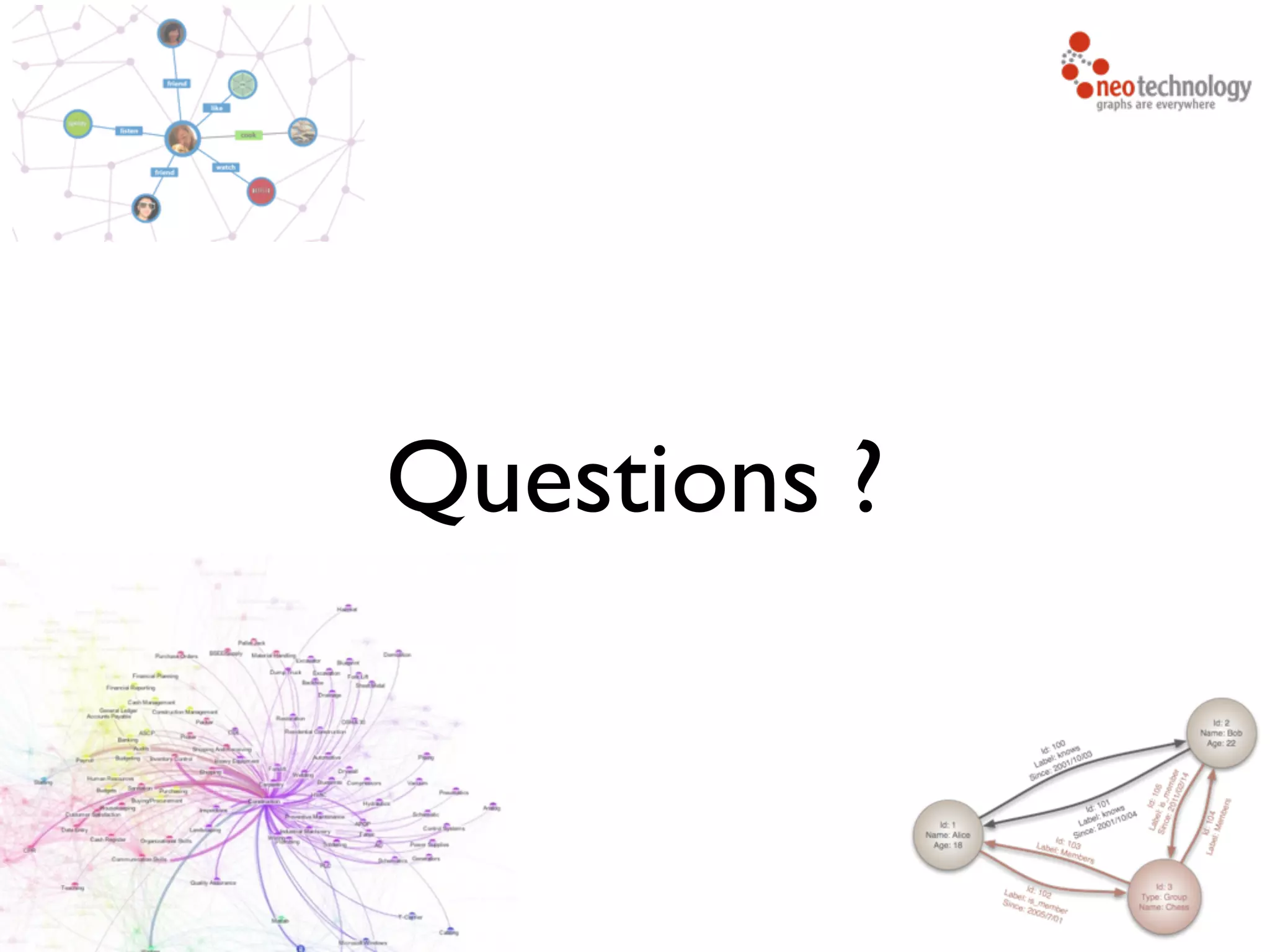The document provides an overview of graph databases, specifically focusing on Neo4j, their architecture, and use cases across various industries. It highlights the advantages of using graph databases over traditional relational databases, particularly in handling complex relationships and improving query performance. Key applications mentioned include social networking, content management, and network dependency management.
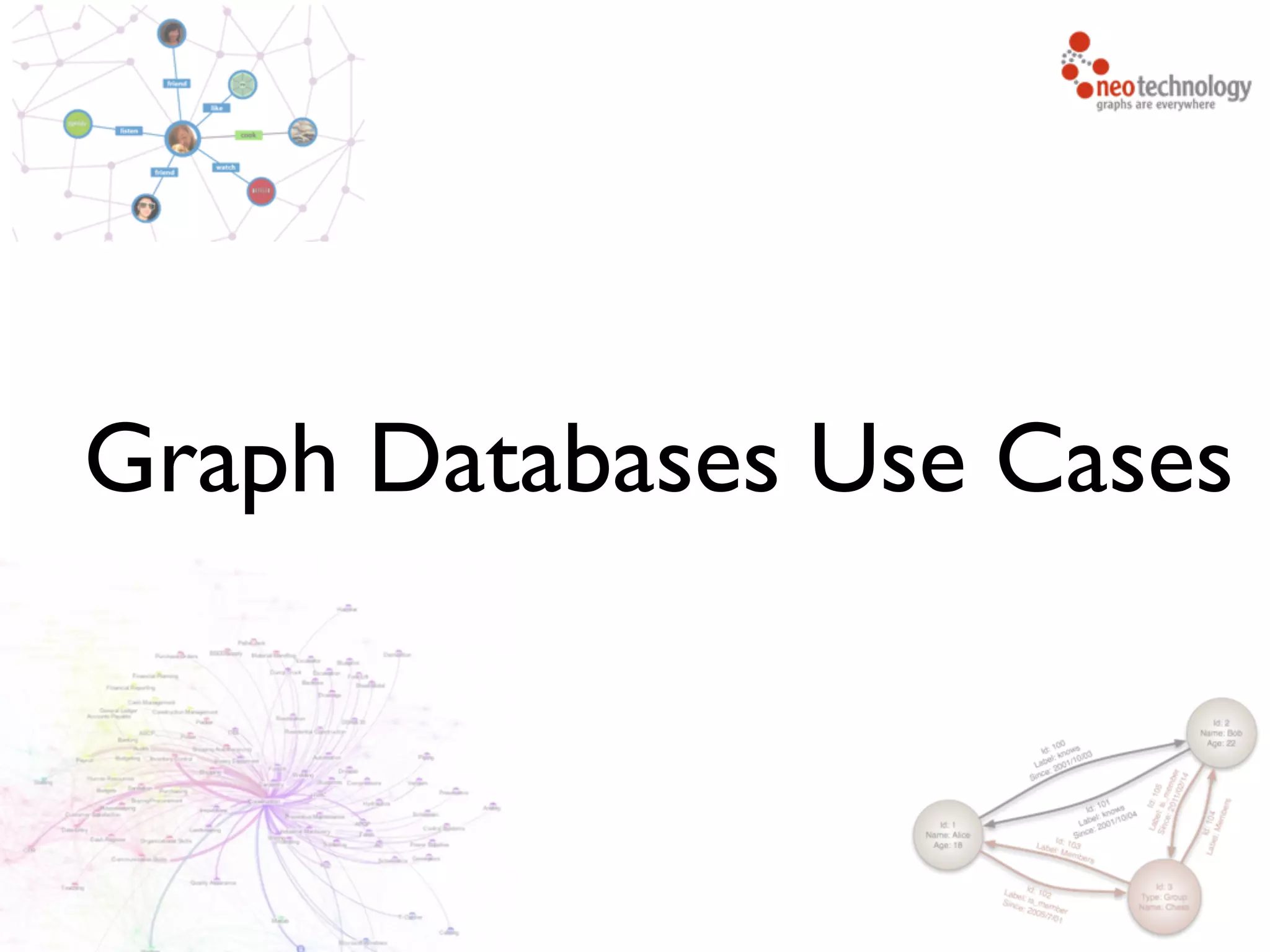
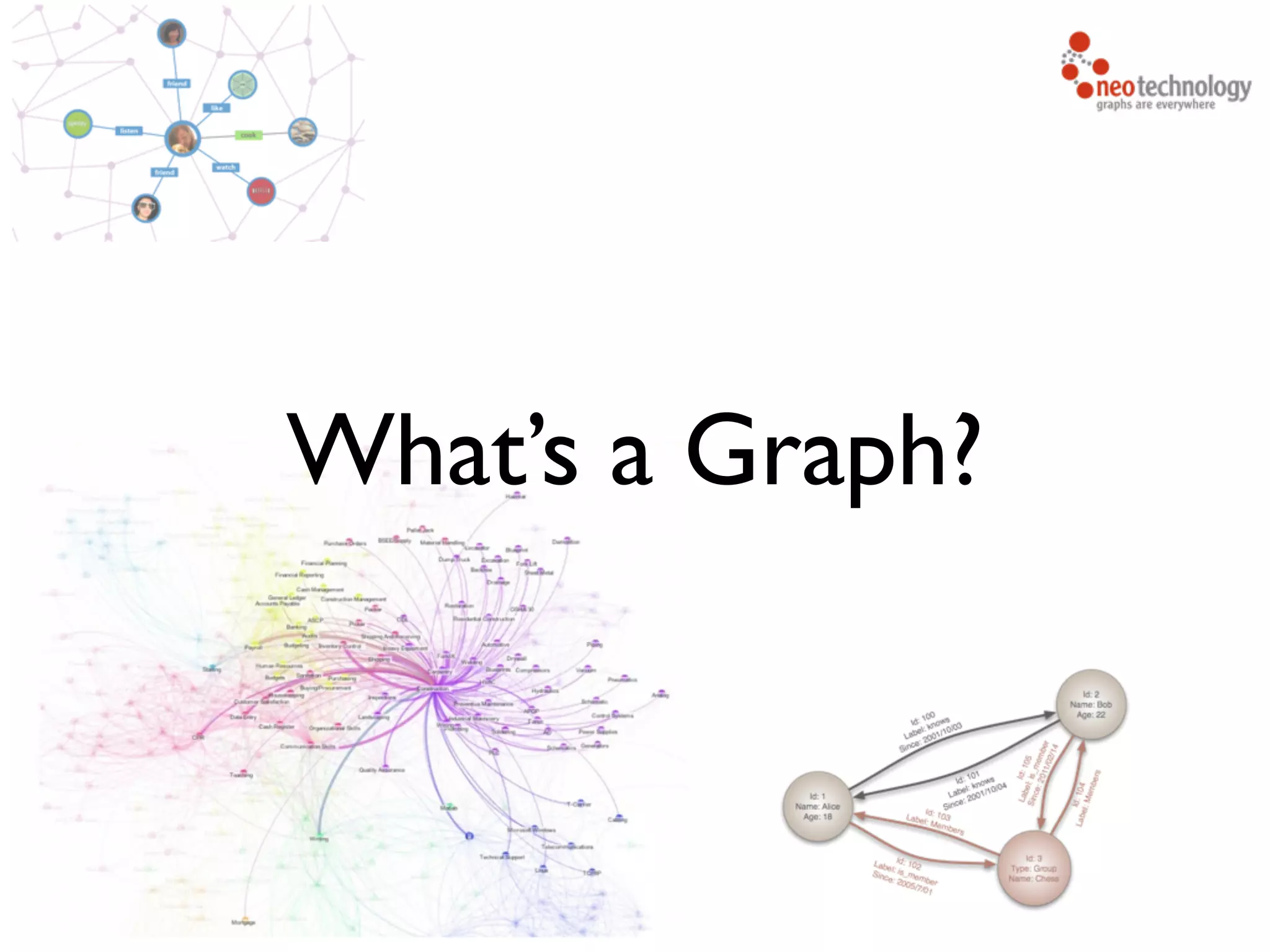
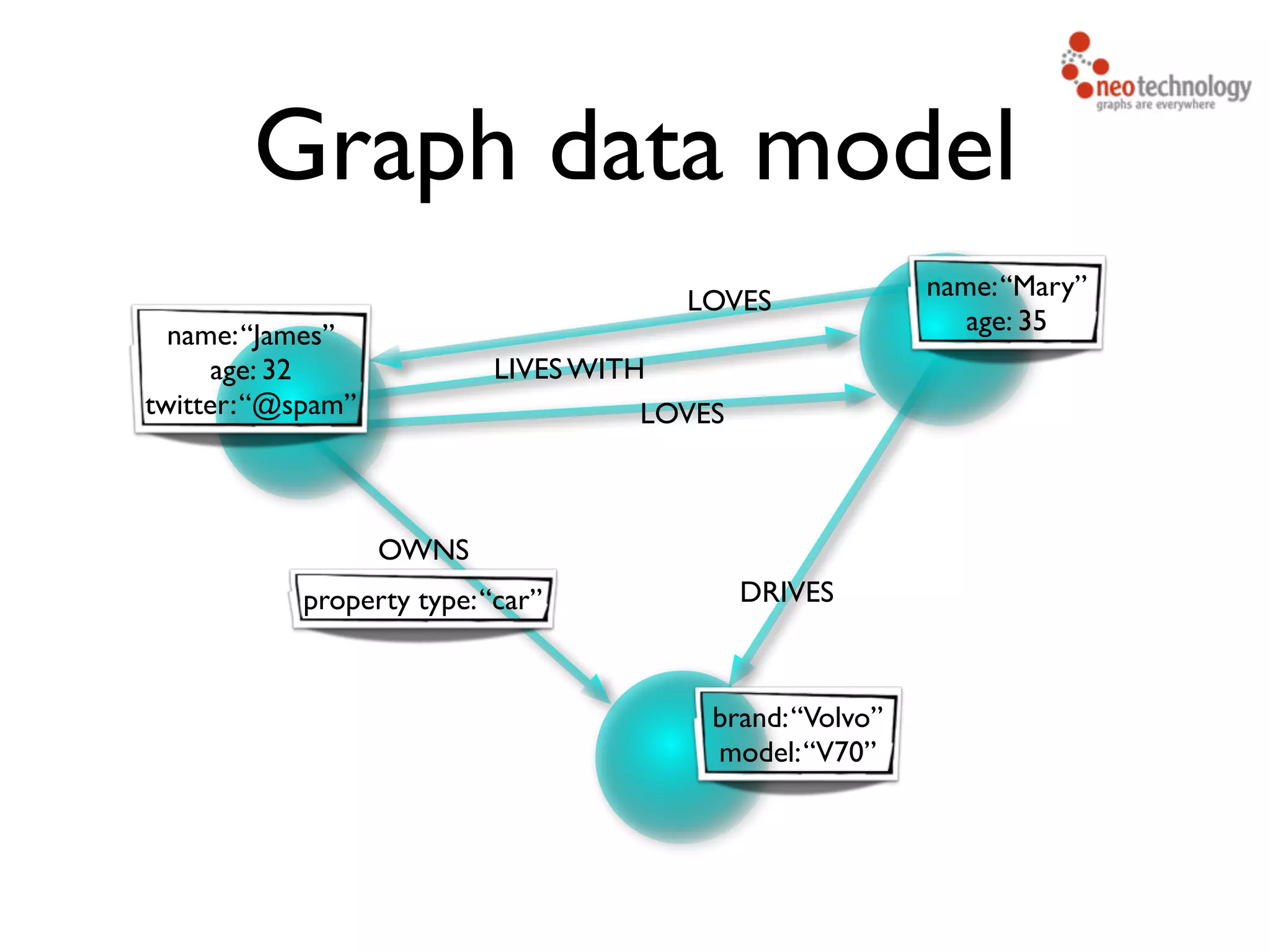

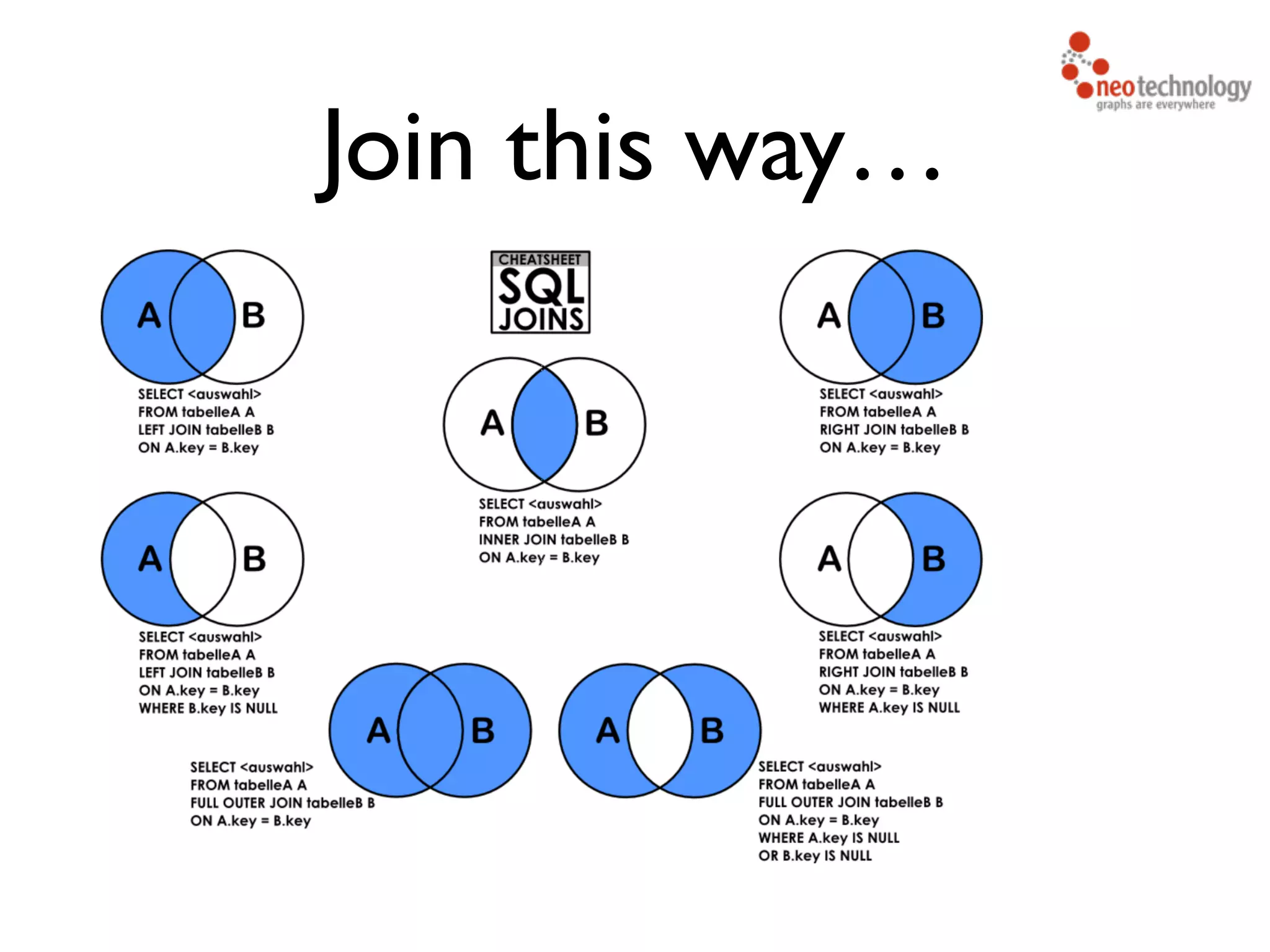
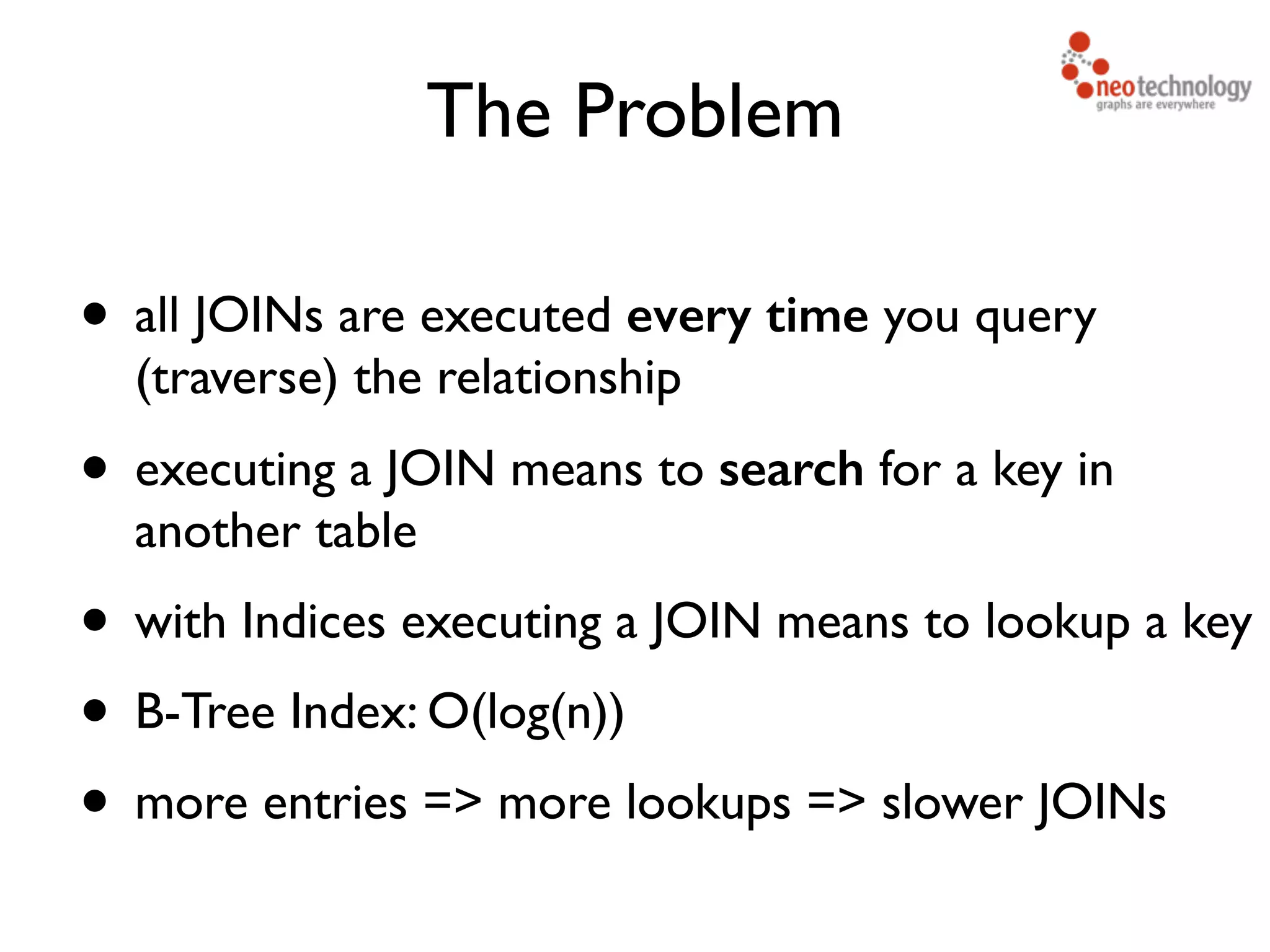
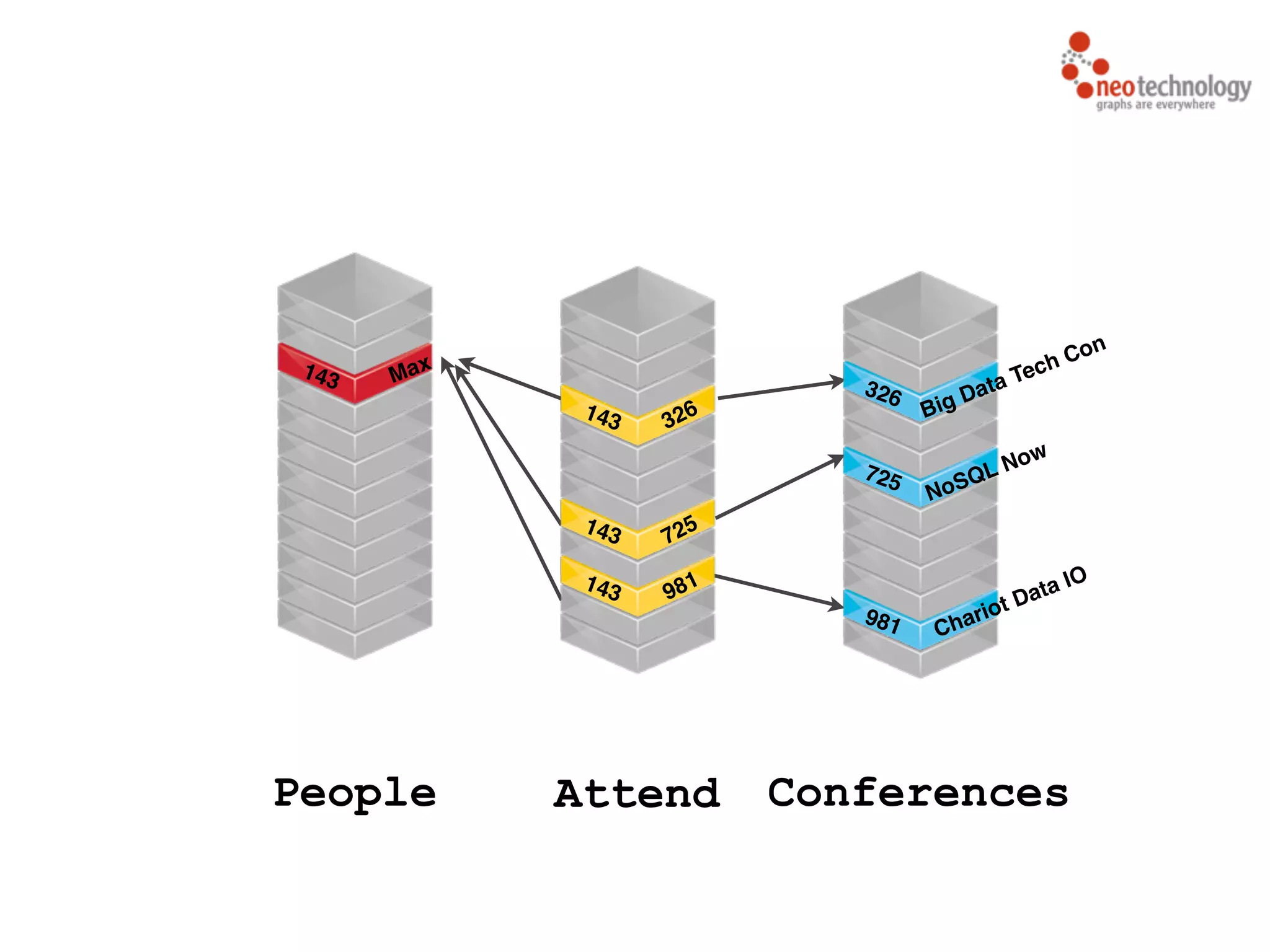
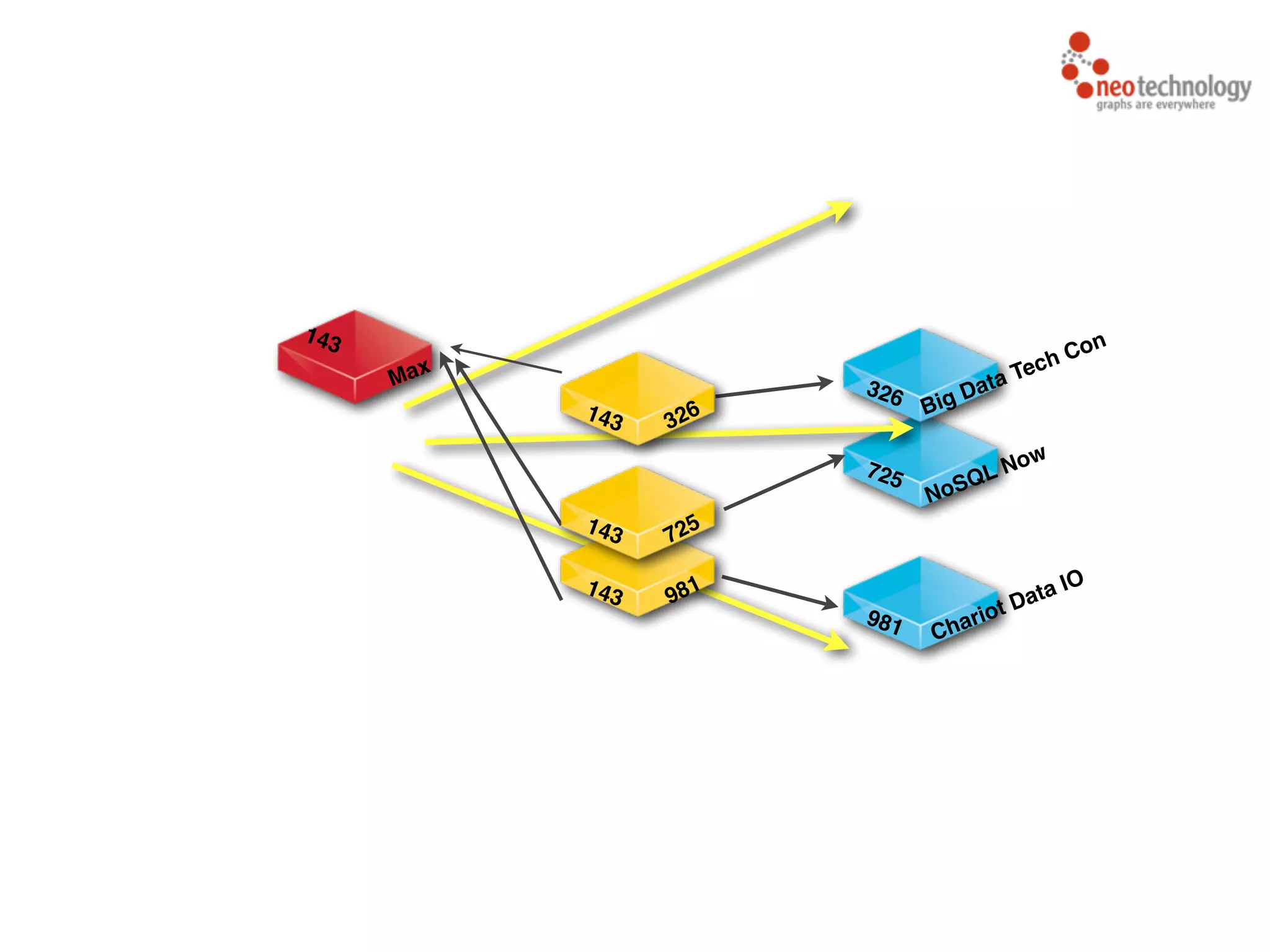
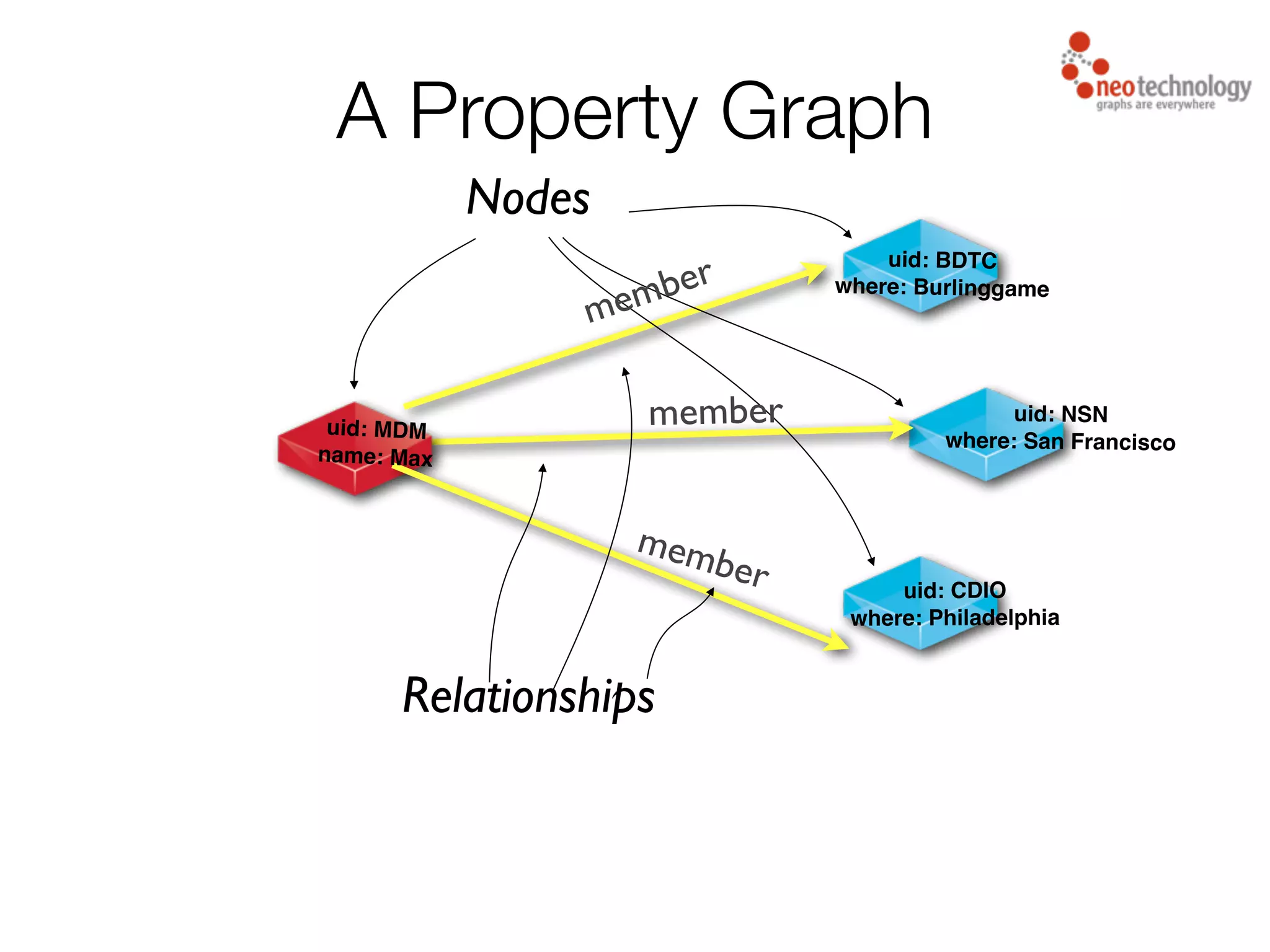
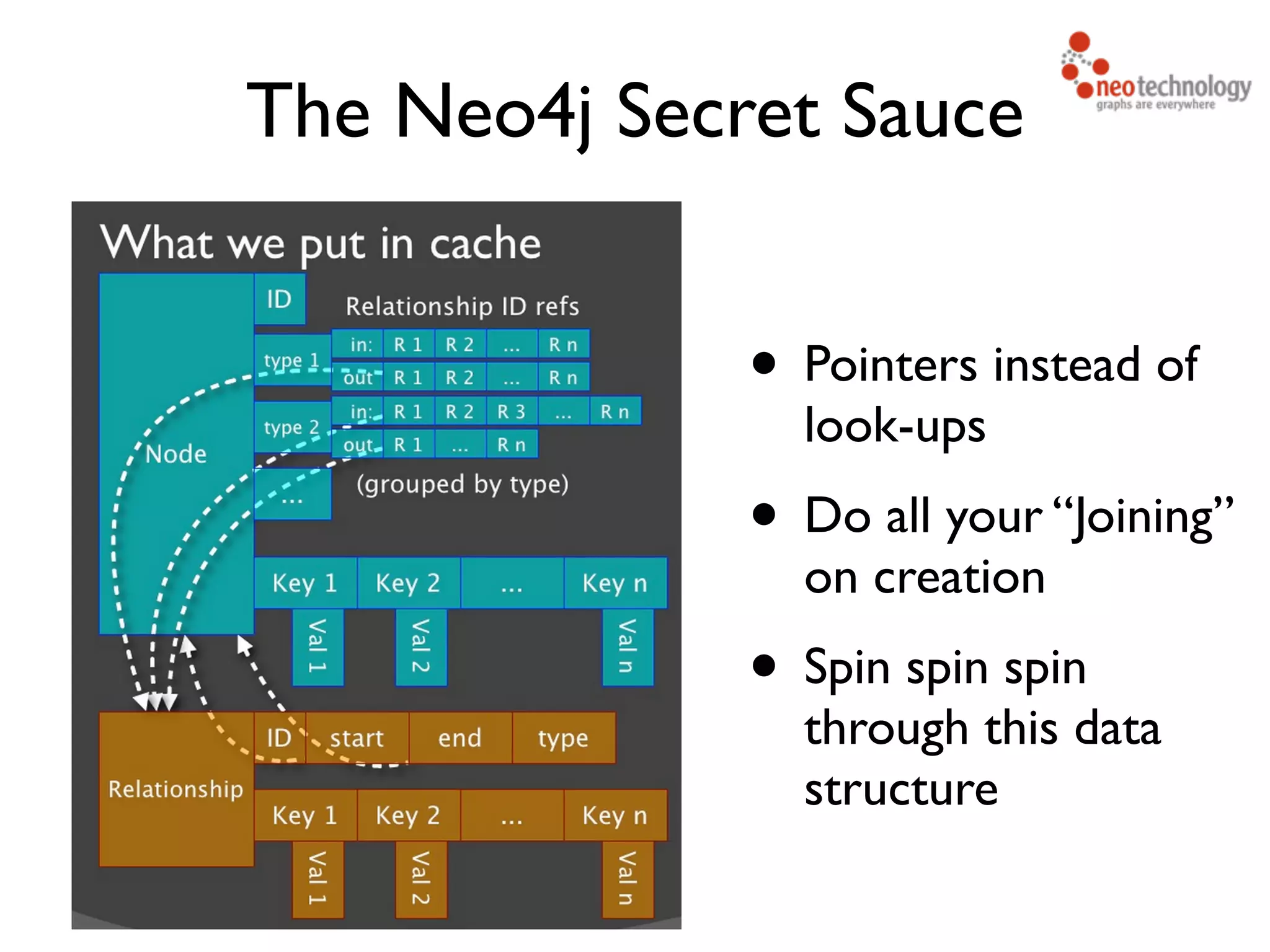



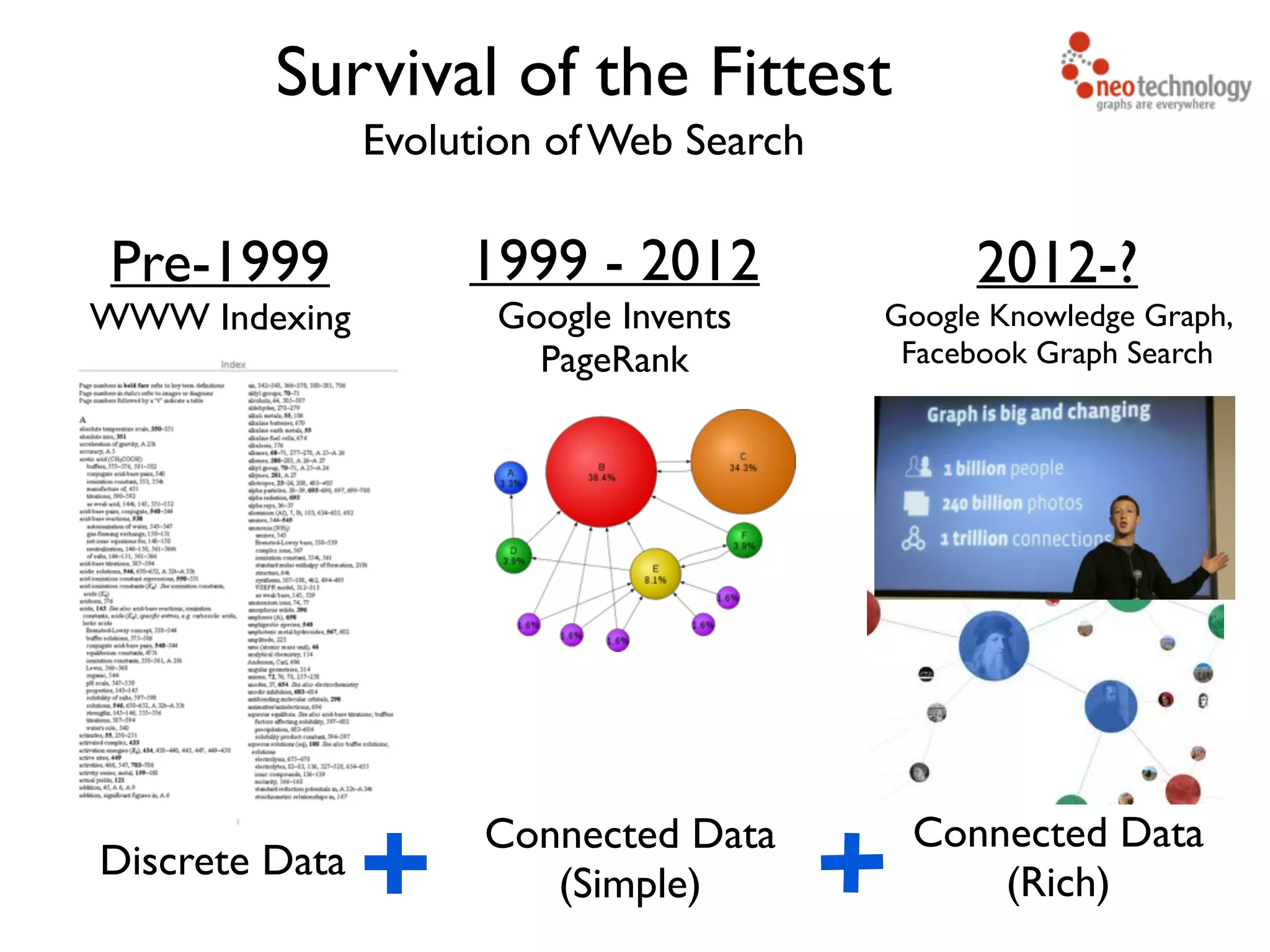
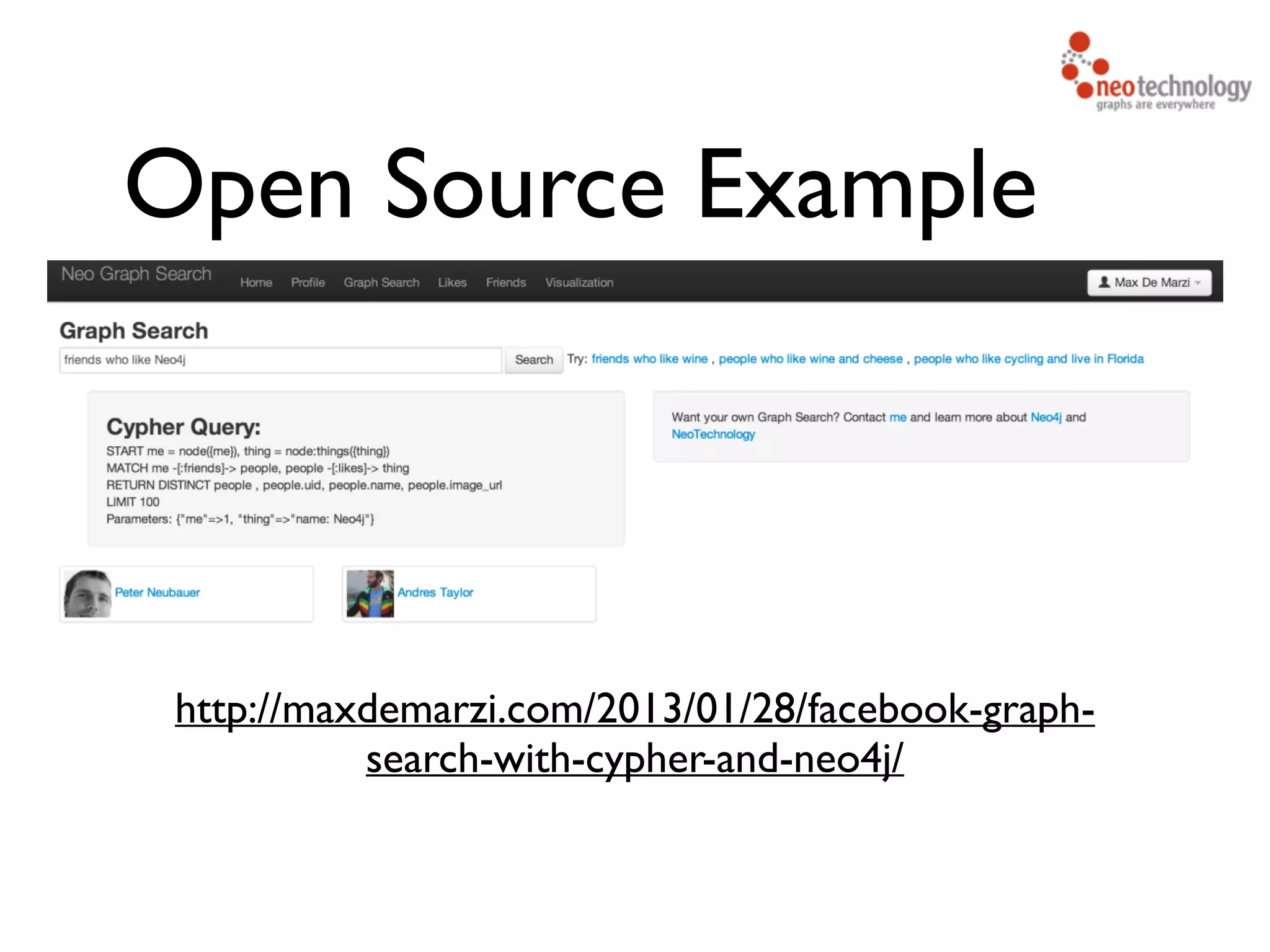
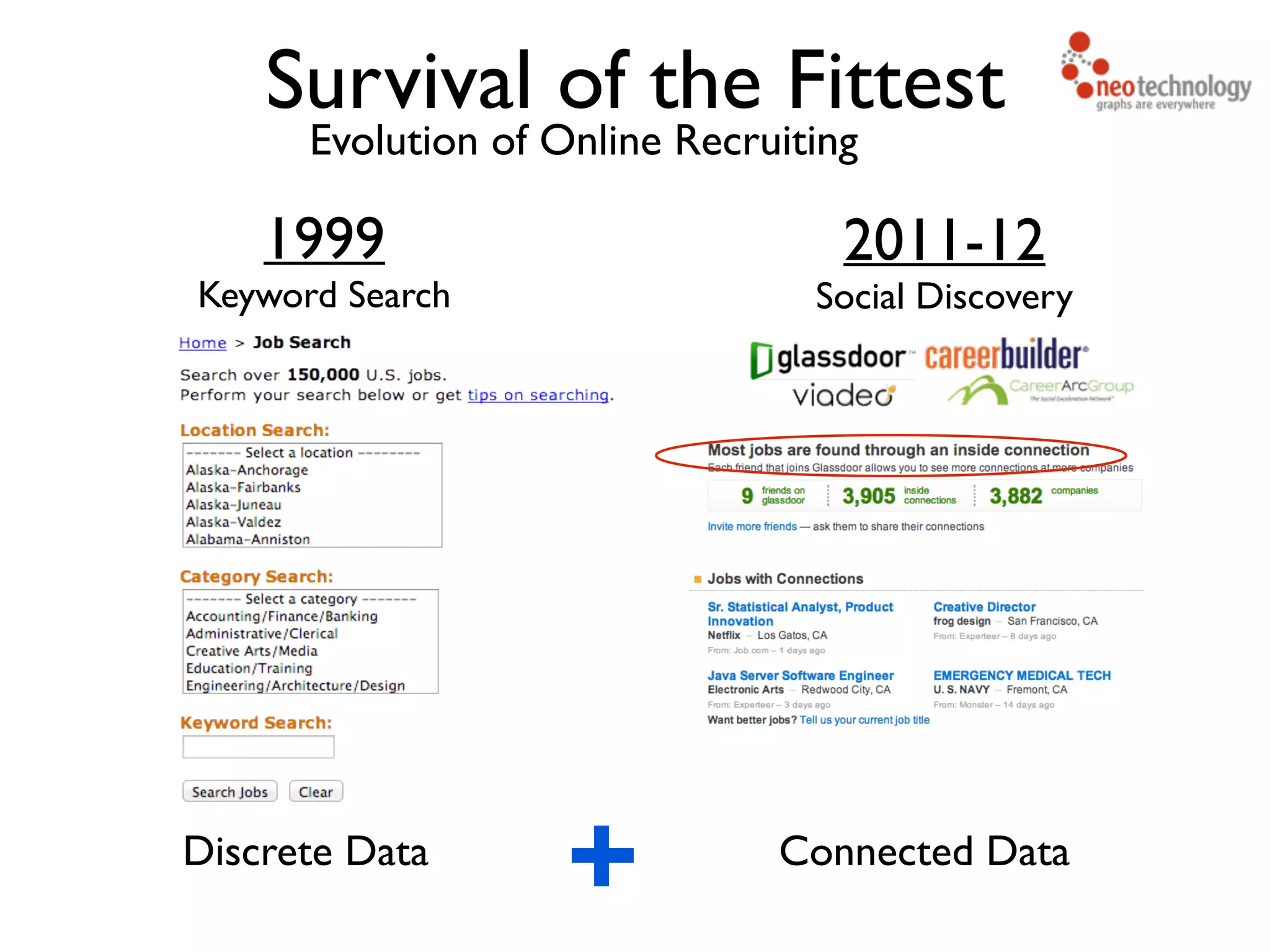

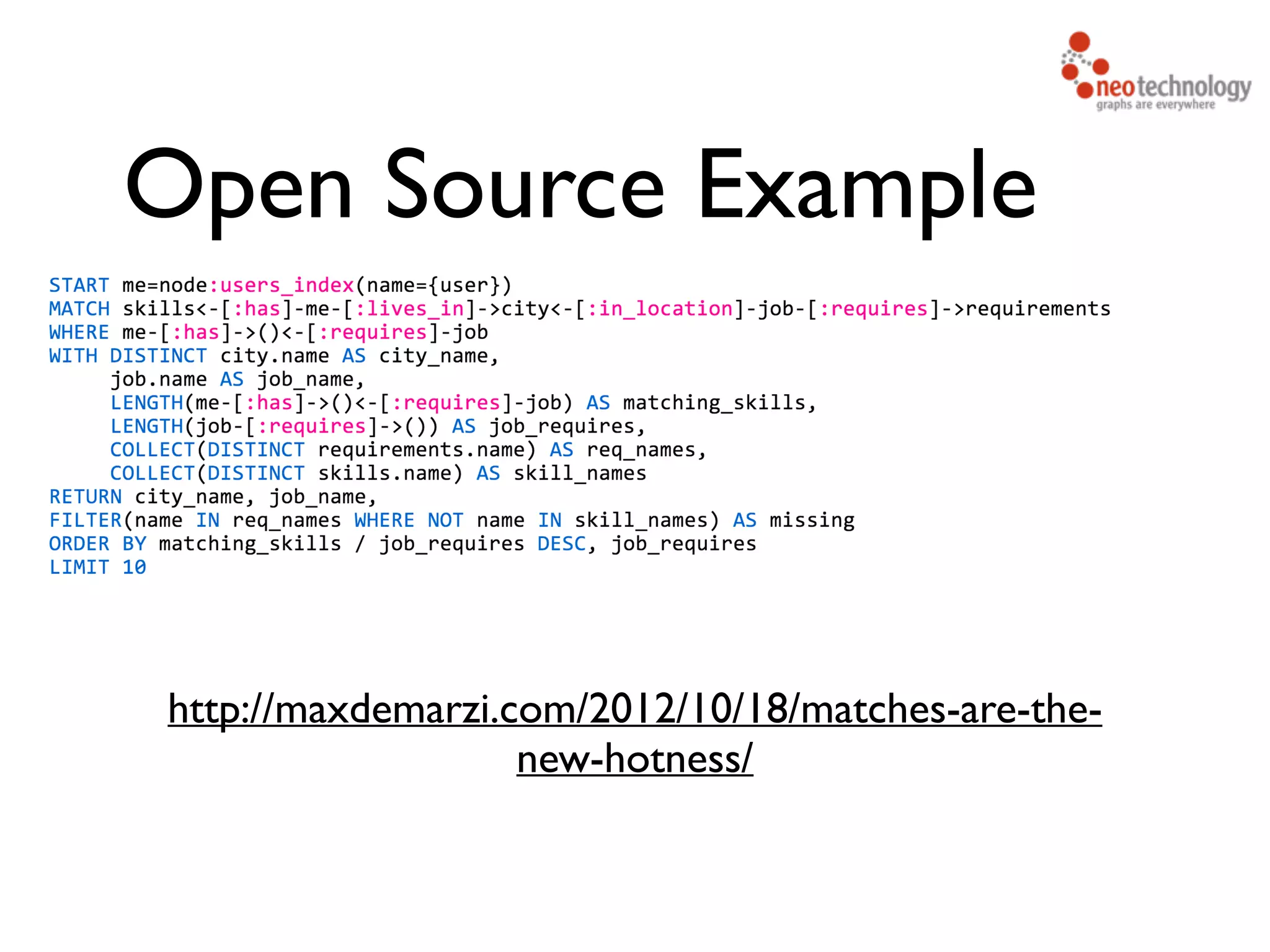

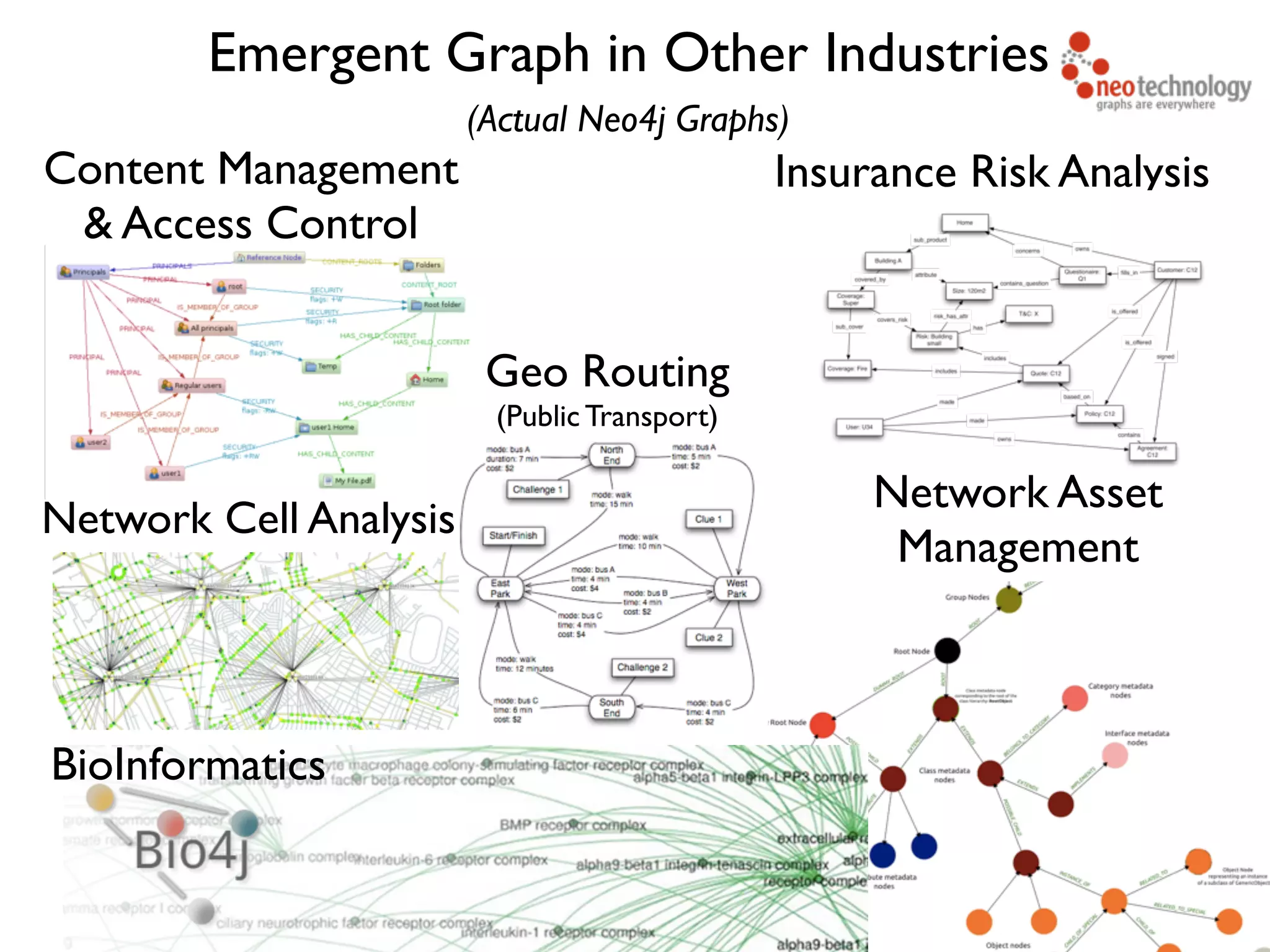
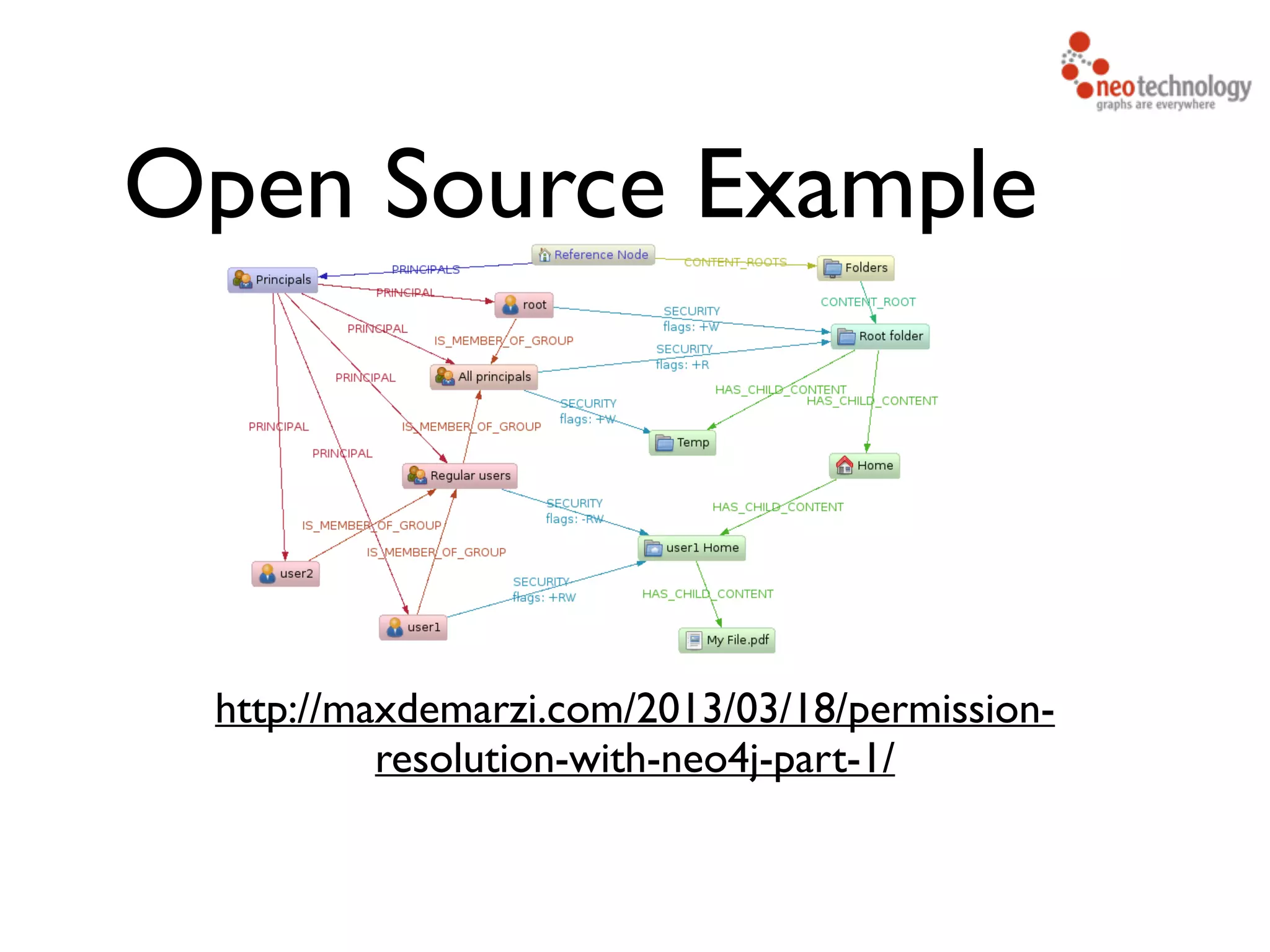
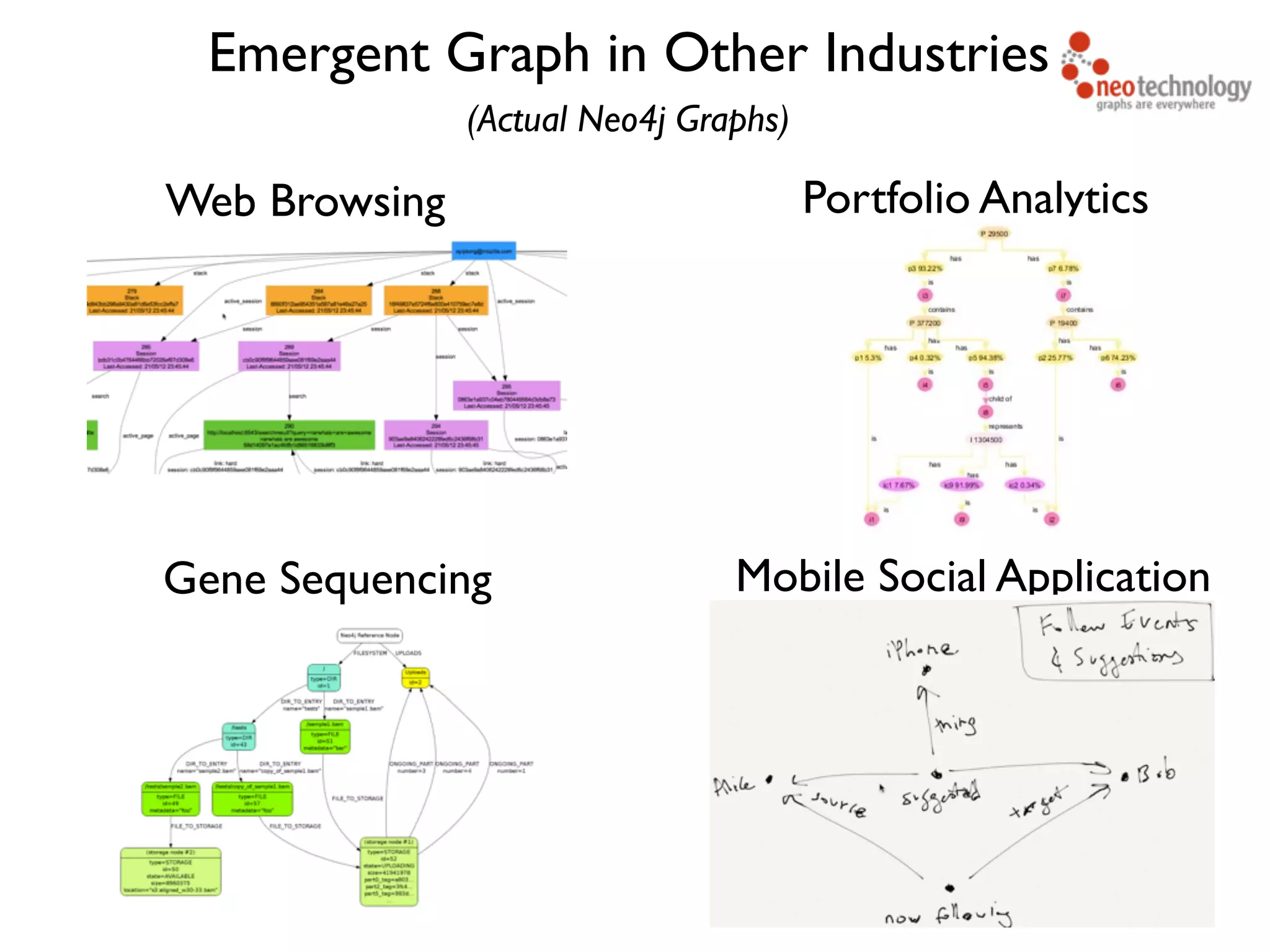


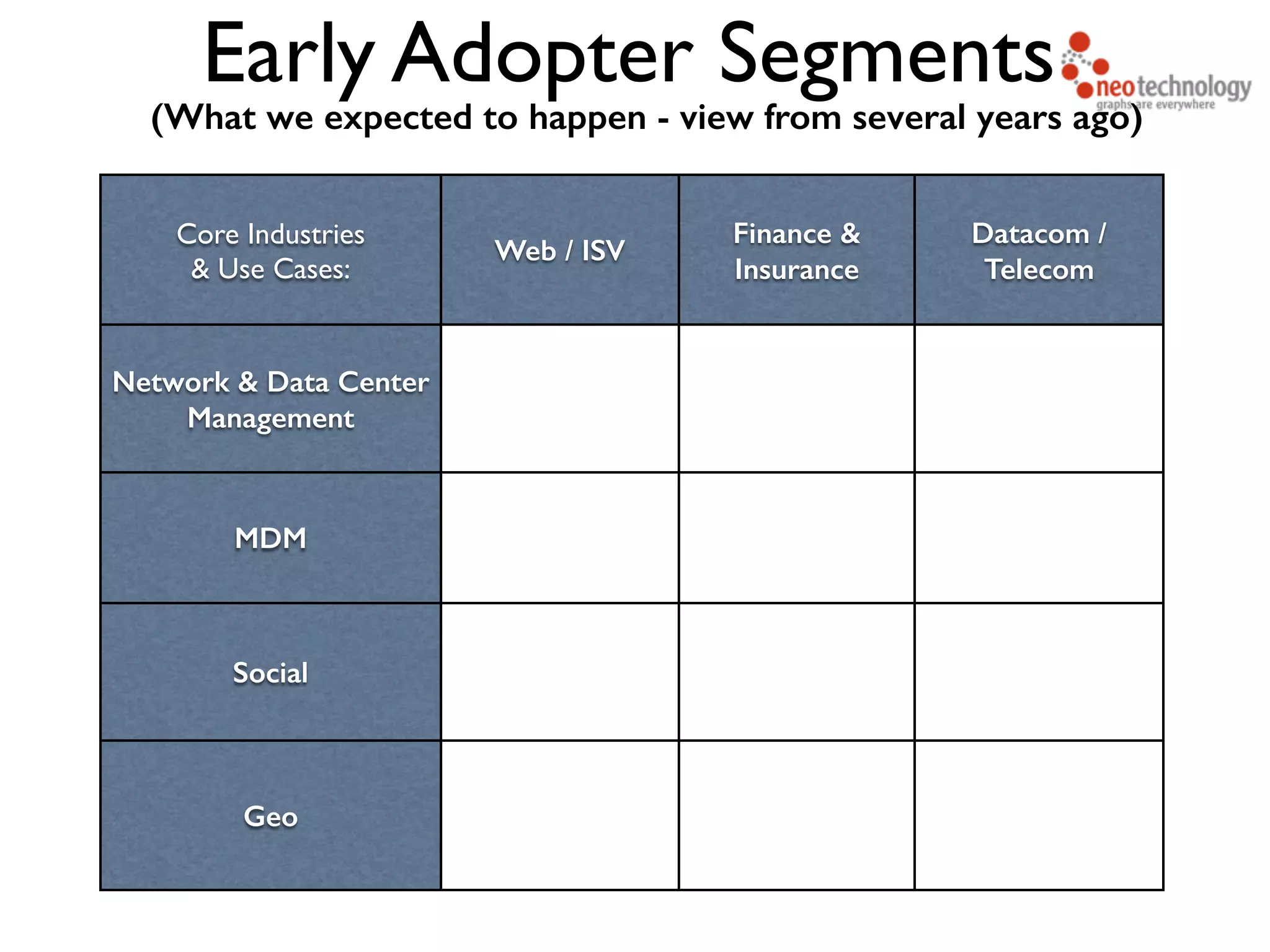

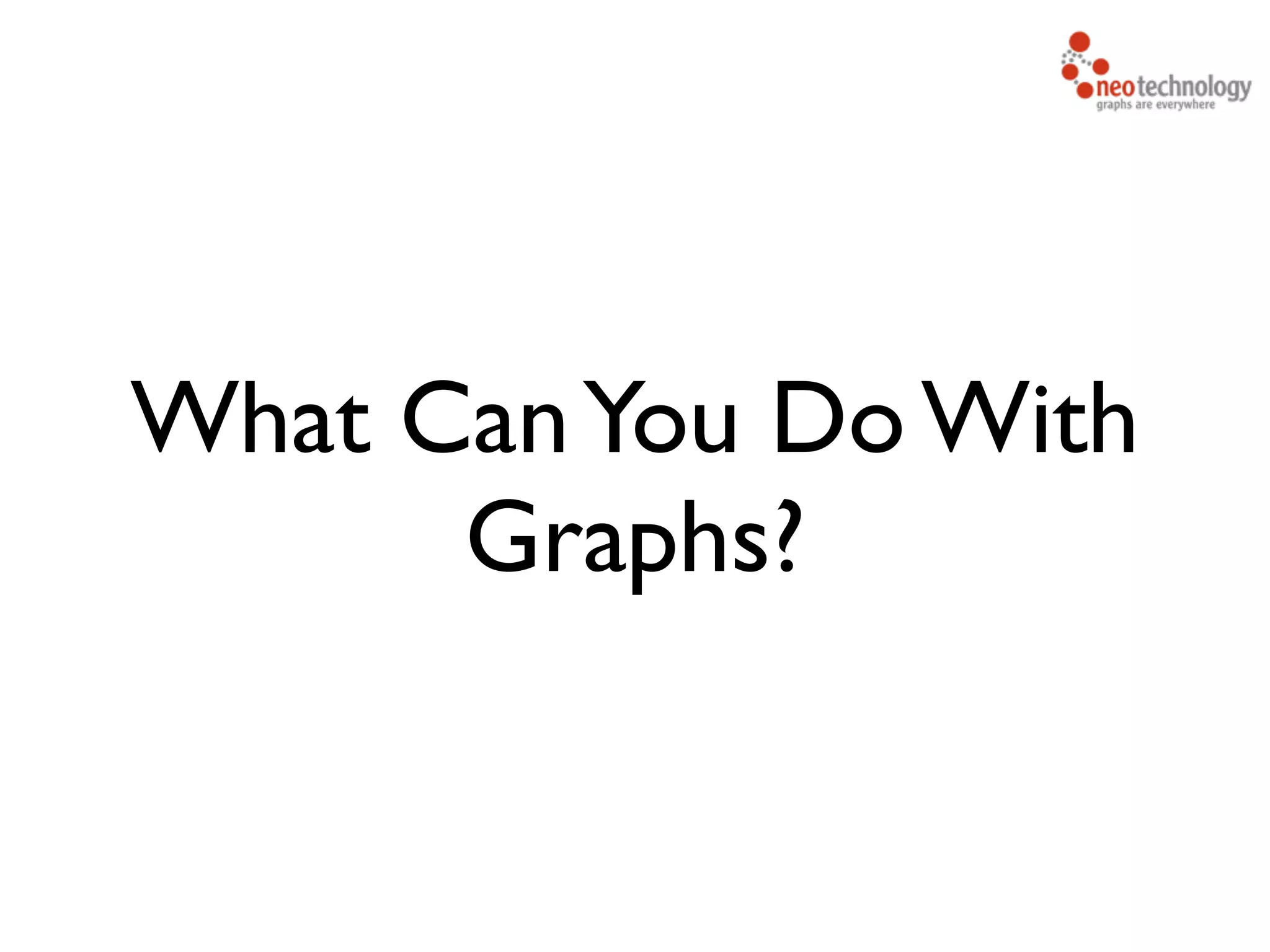
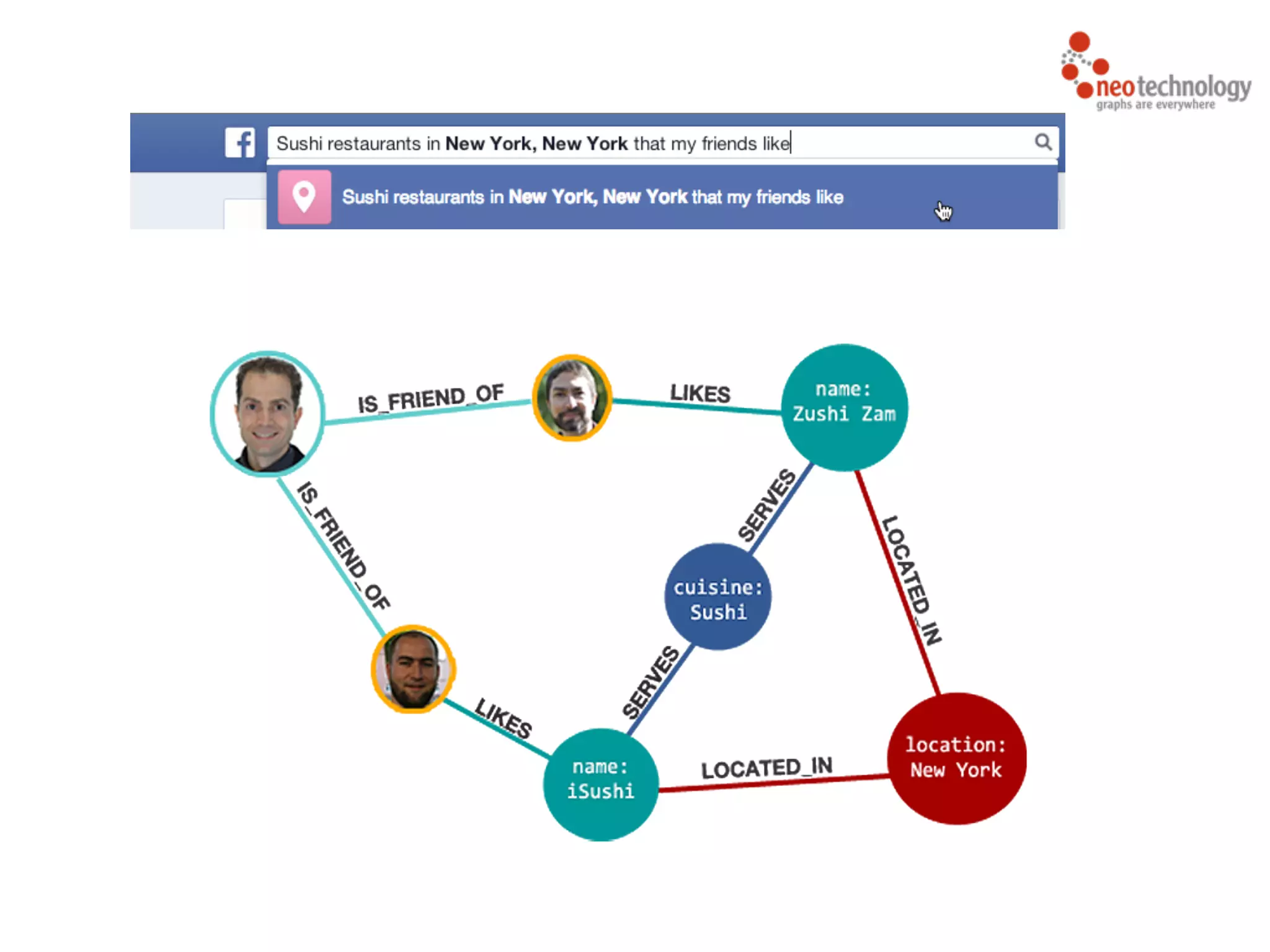
![MATCH (me:Person)-[:IS_FRIEND_OF]->(friend), (friend)-[:LIKES]->(restaurant), (restaurant)-[:LOCATED_IN]->(city:Location), (restaurant)-[:SERVES]->(cuisine:Cuisine) ! WHERE me.name = 'Philip' AND city.location='New York' AND cuisine.cuisine='Sushi' ! RETURN restaurant.name * Cypher query language examplehttp://maxdemarzi.com/?s=facebook](https://image.slidesharecdn.com/graphdatabaseusecases-stampedecon2015-150903113225-lva1-app6892/75/Graph-Database-Use-Cases-StampedeCon-2015-29-2048.jpg)



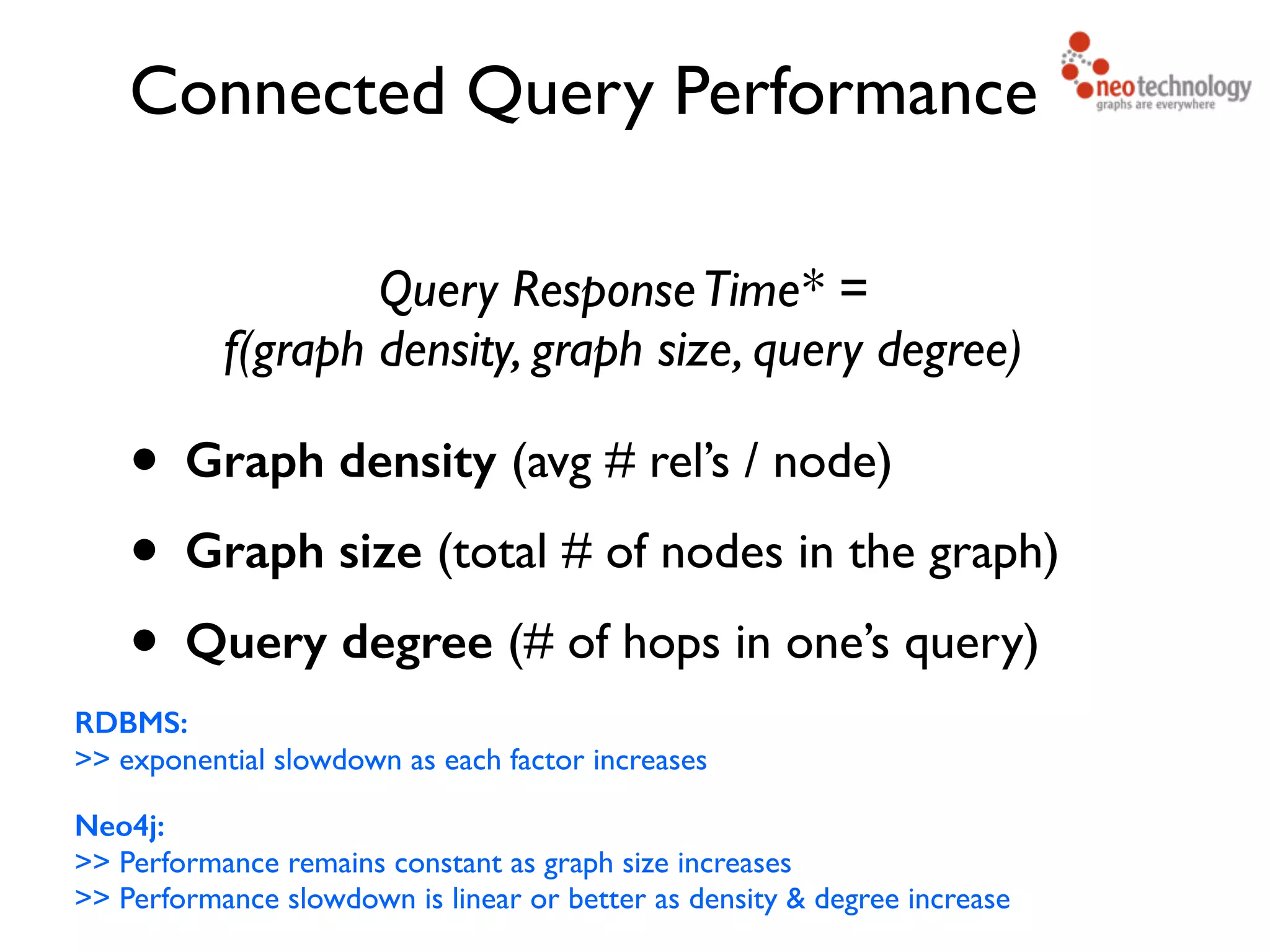
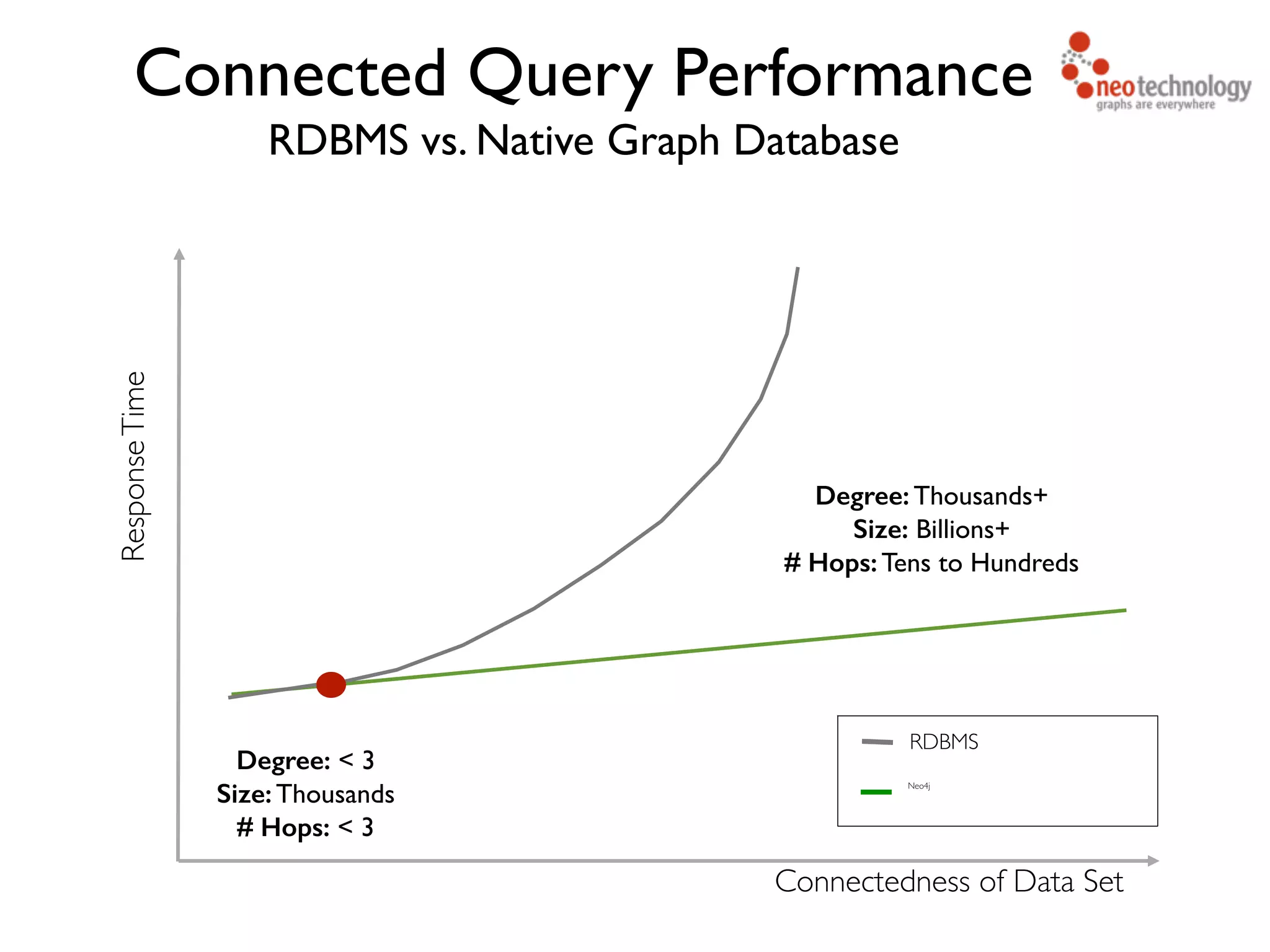
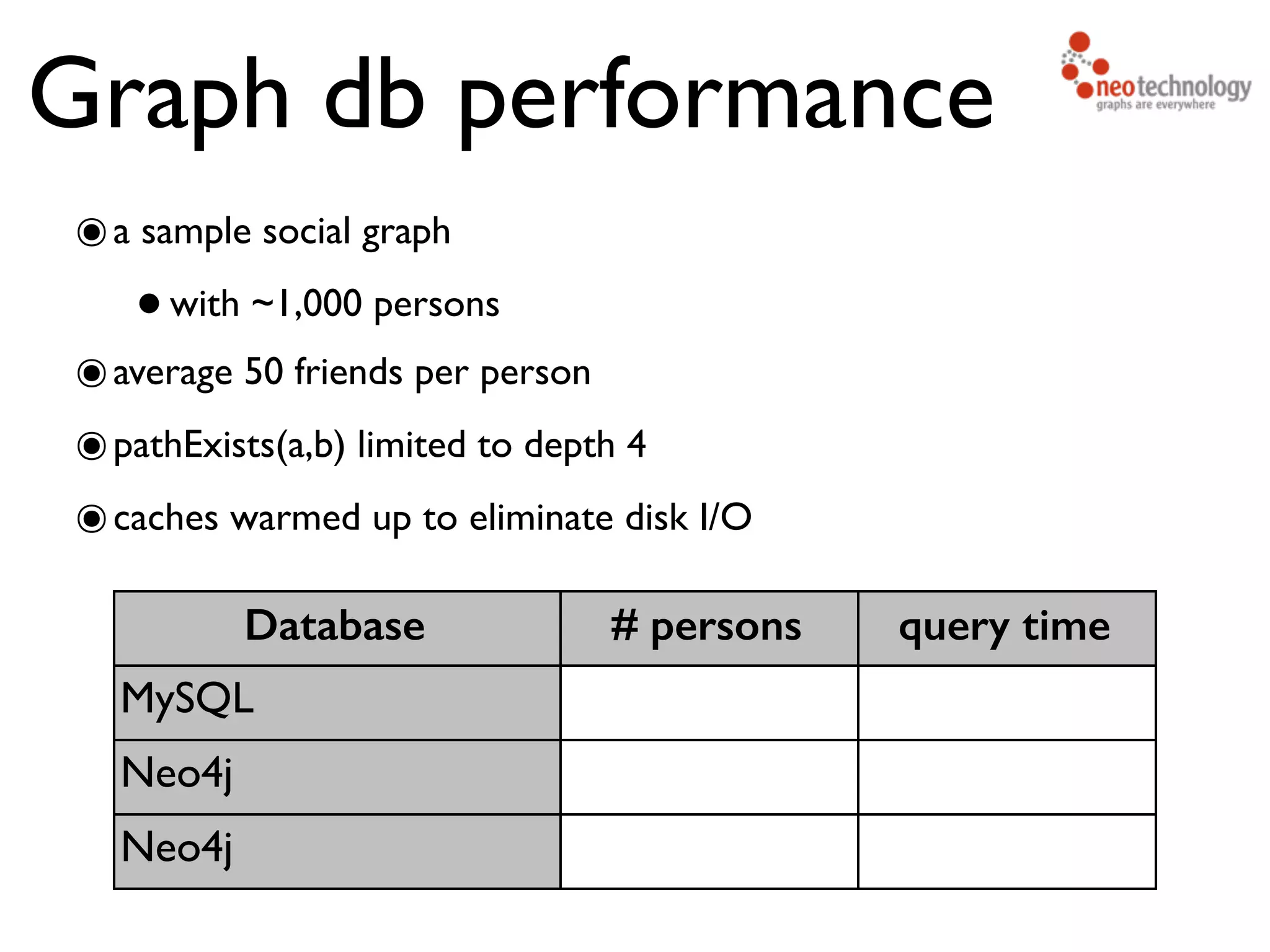
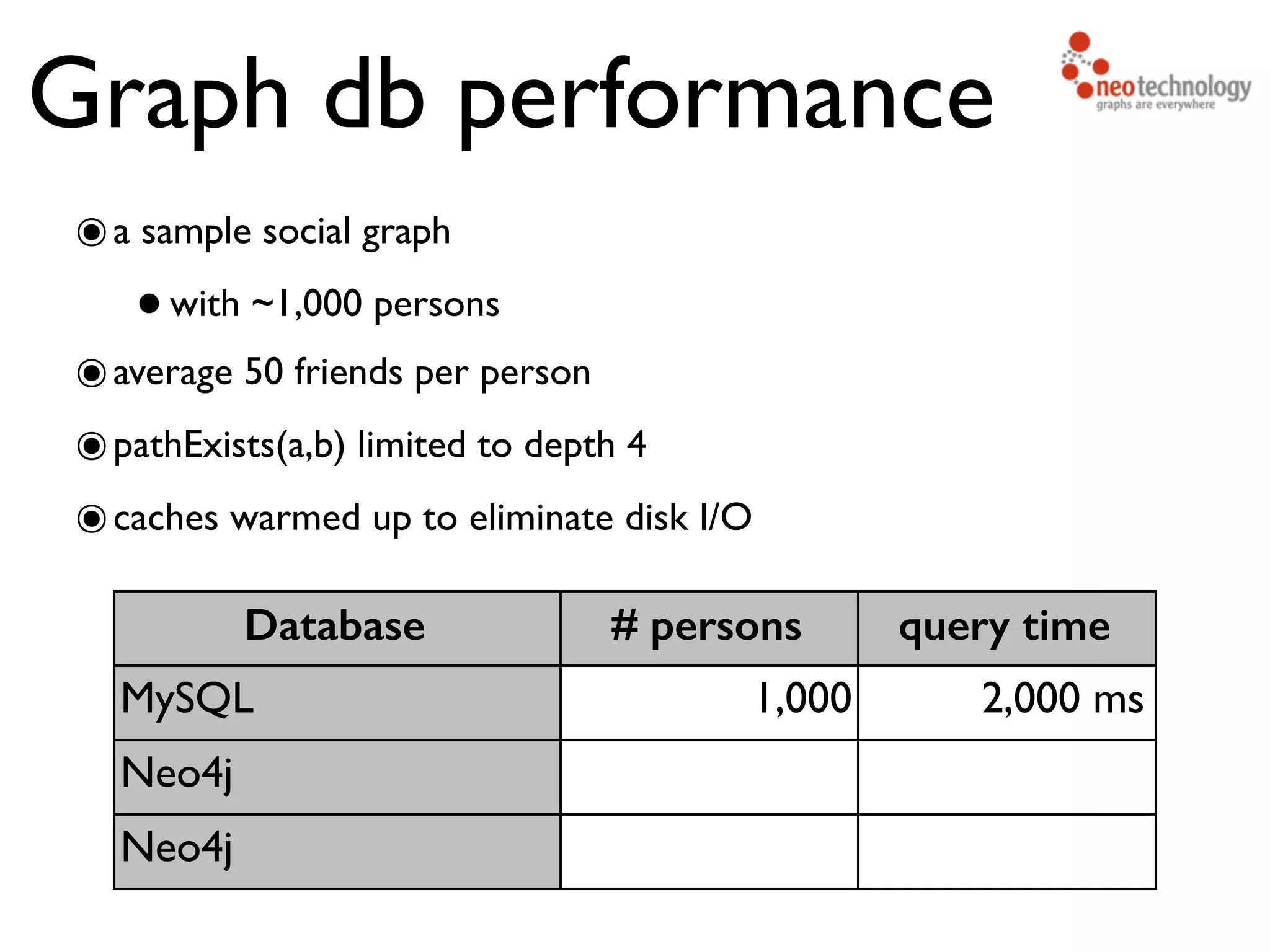
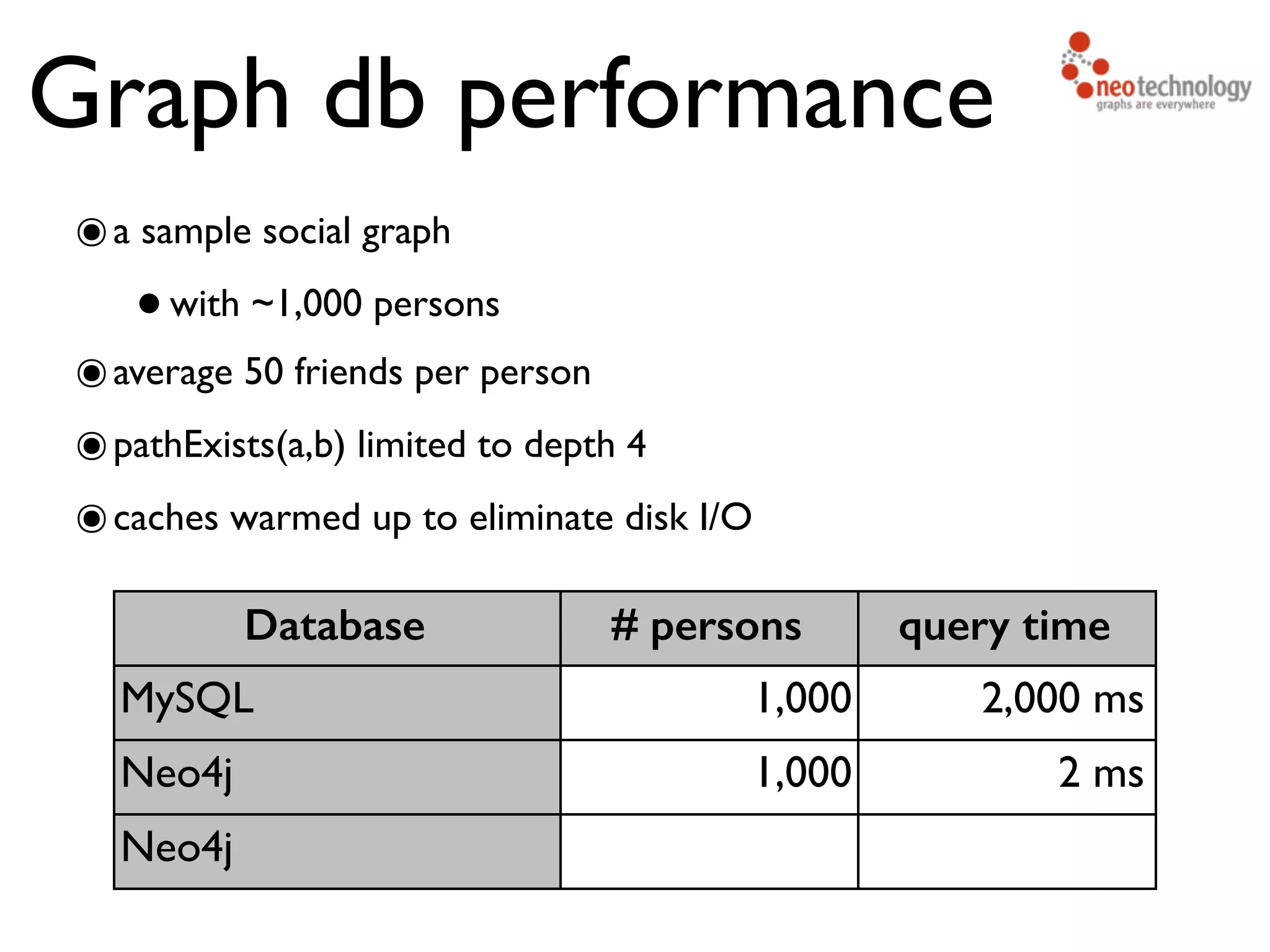


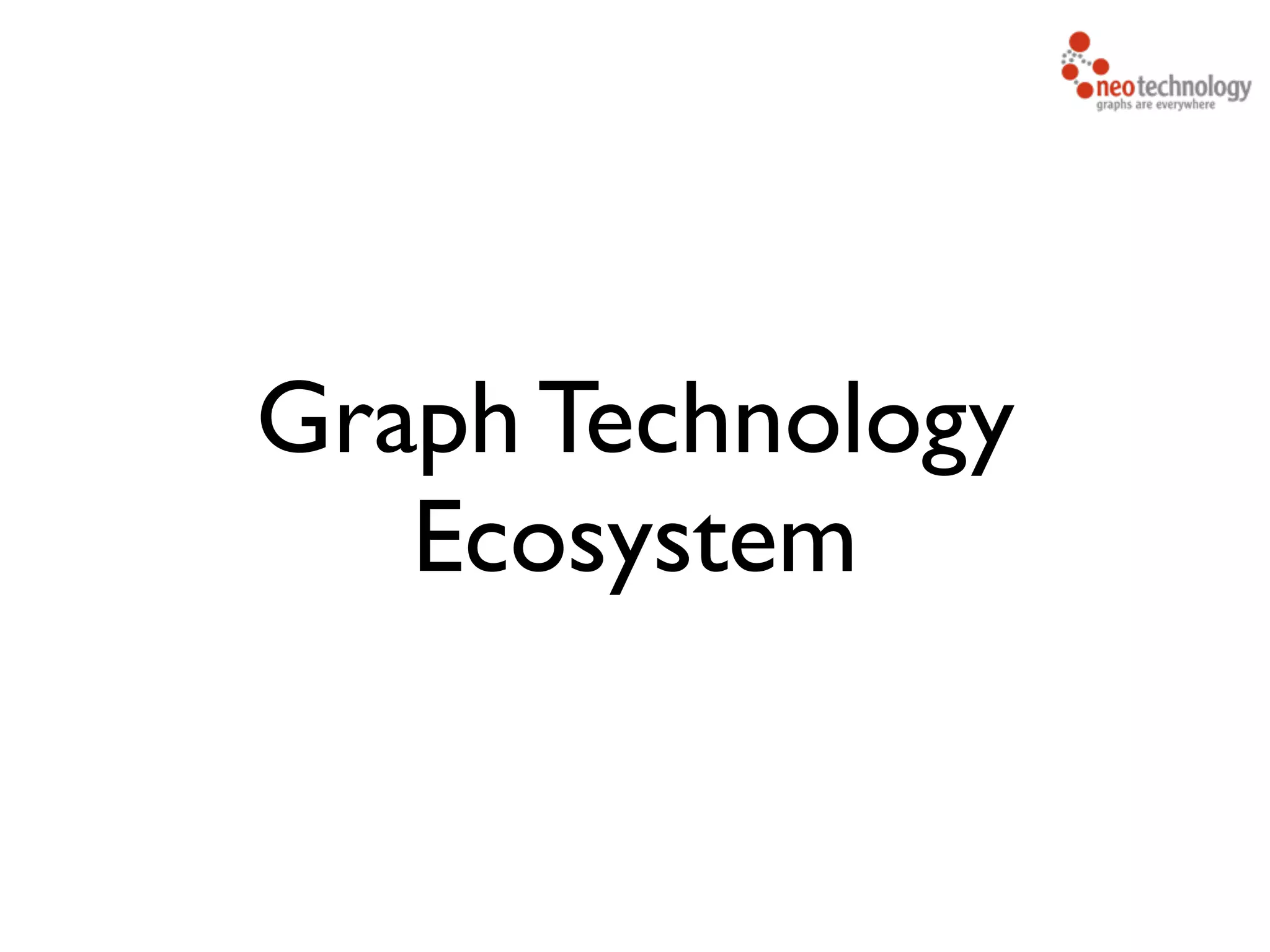
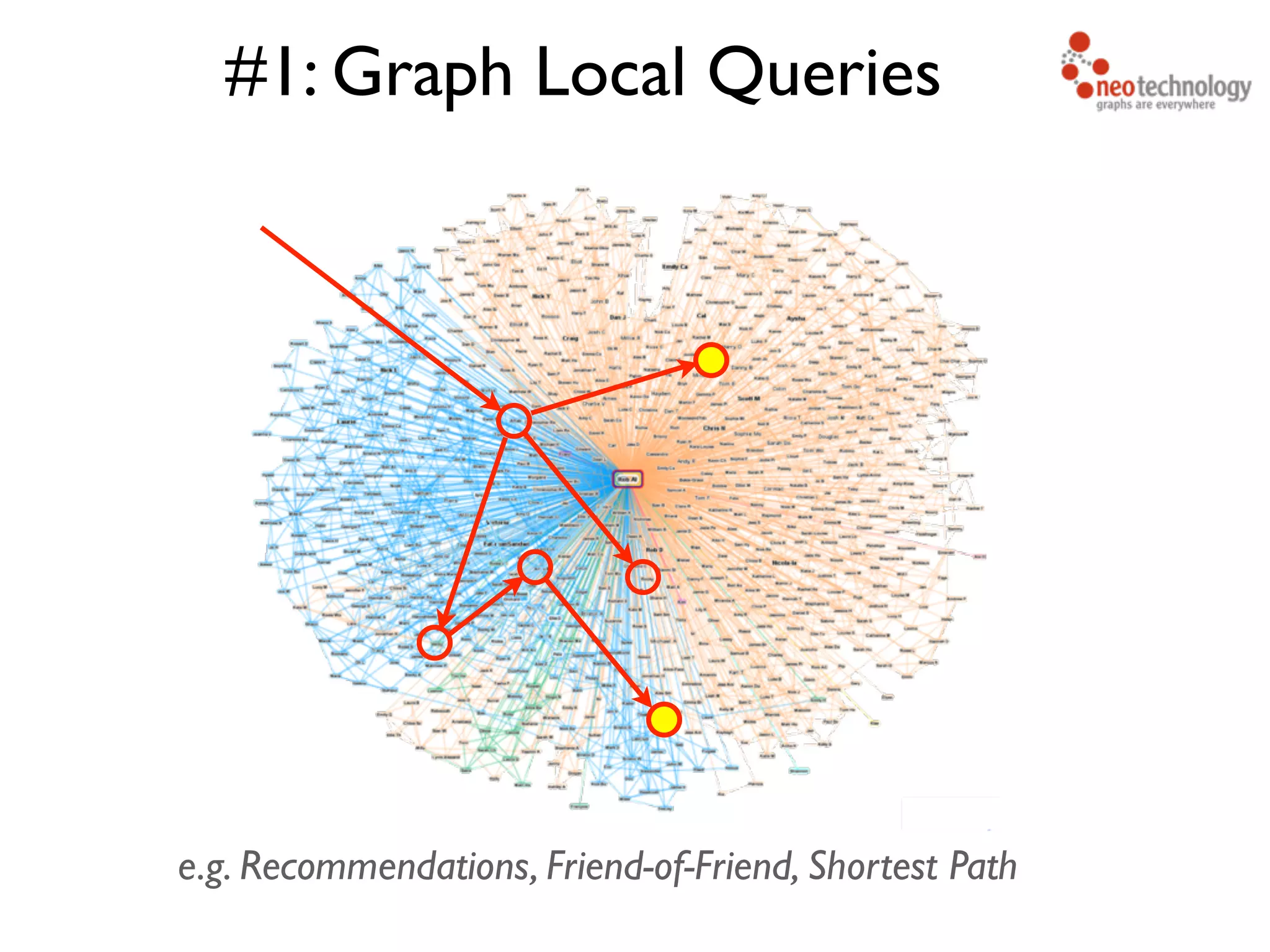
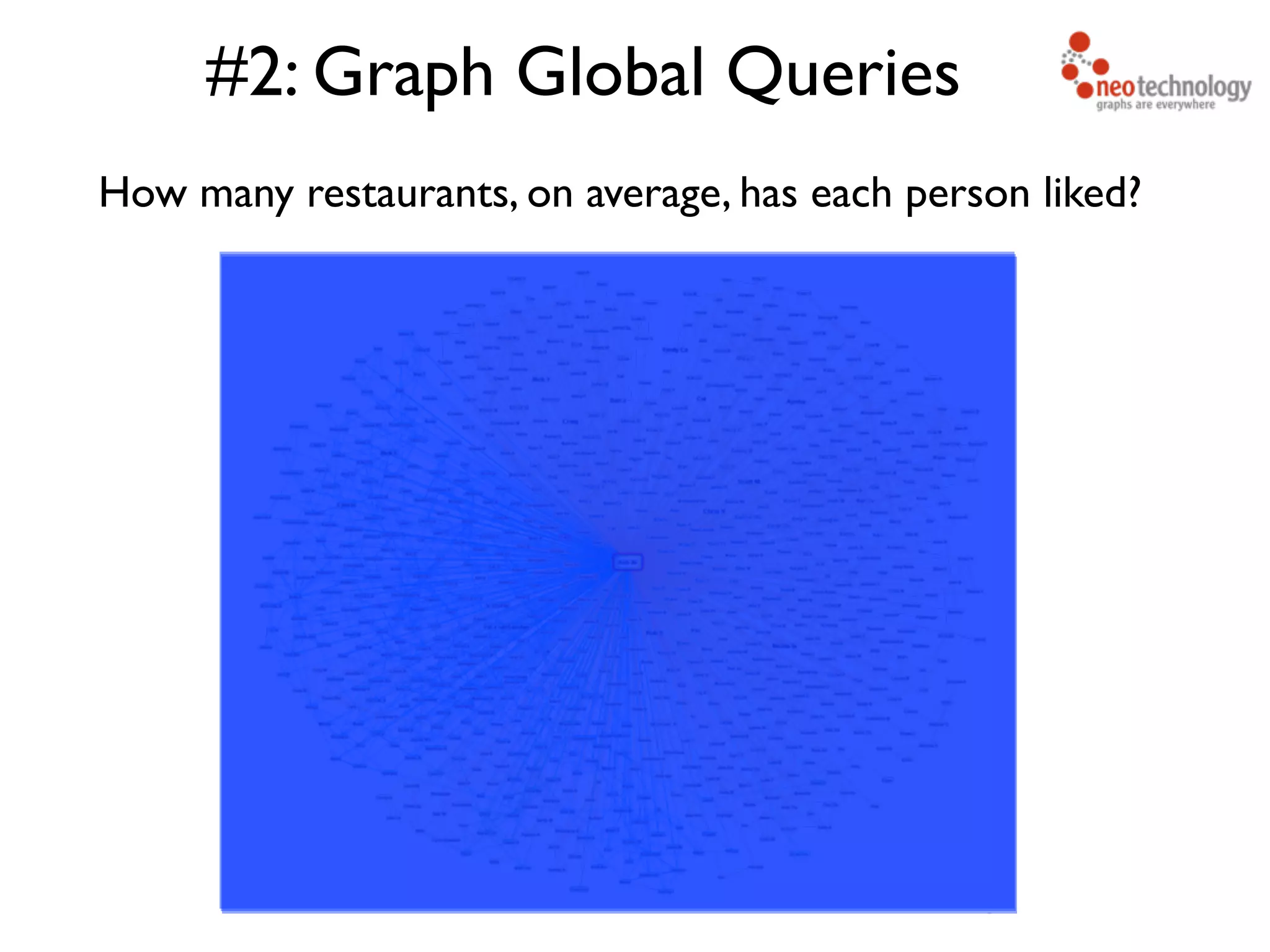
![What is a Graph Database “A graph database... is an online database management system with CRUD methods that expose a graph data model”1 • Two important properties: • Native graph storage engine: written from the ground up to manage graph data • Native graph processing, including
index-free adjacency to facilitate traversals 1] Robinson,Webber, Eifrem. Graph Databases. O’Reilly, 2013. p. 5. ISBN-10: 1449356265](https://image.slidesharecdn.com/graphdatabaseusecases-stampedecon2015-150903113225-lva1-app6892/75/Graph-Database-Use-Cases-StampedeCon-2015-43-2048.jpg)
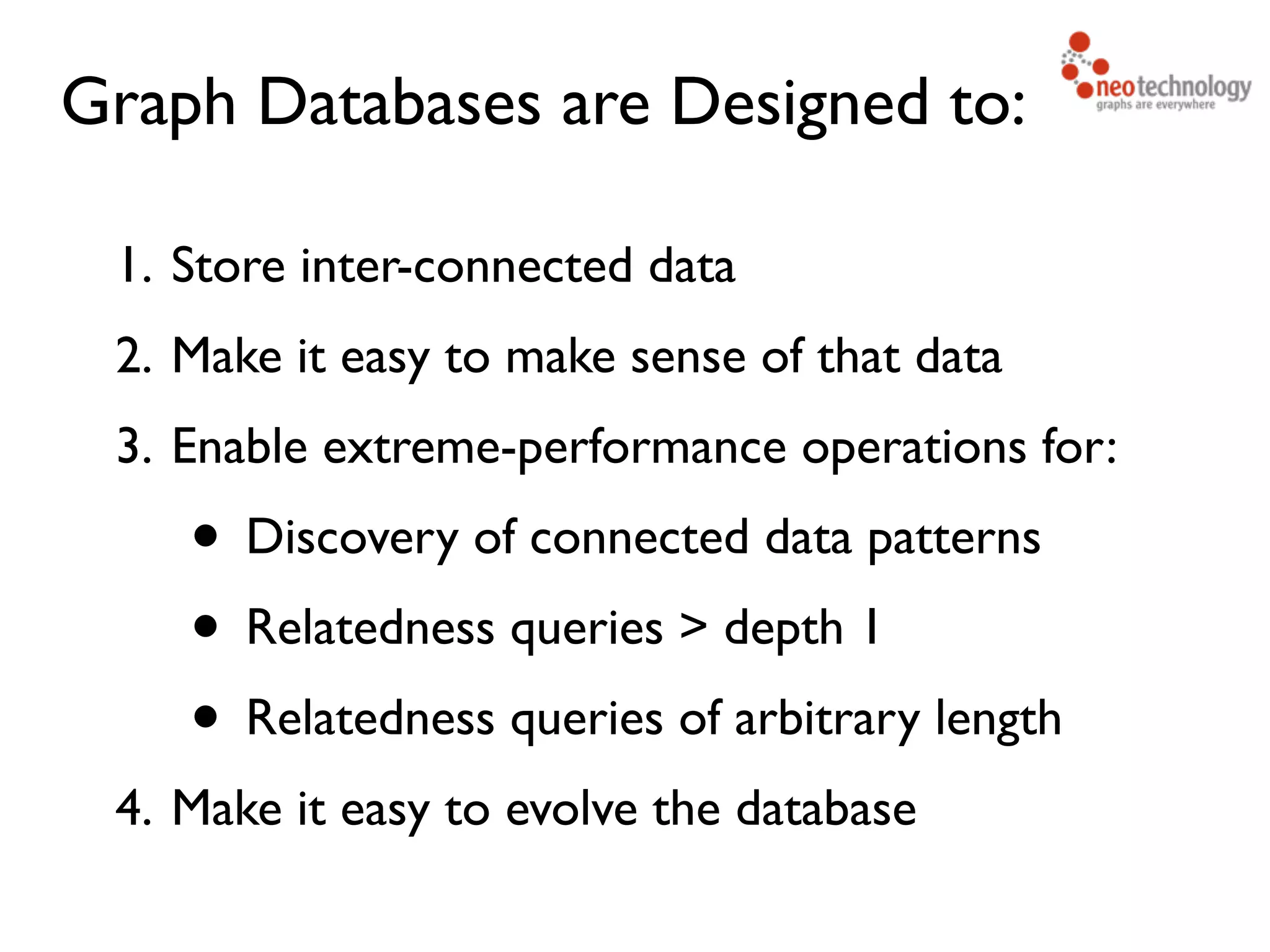
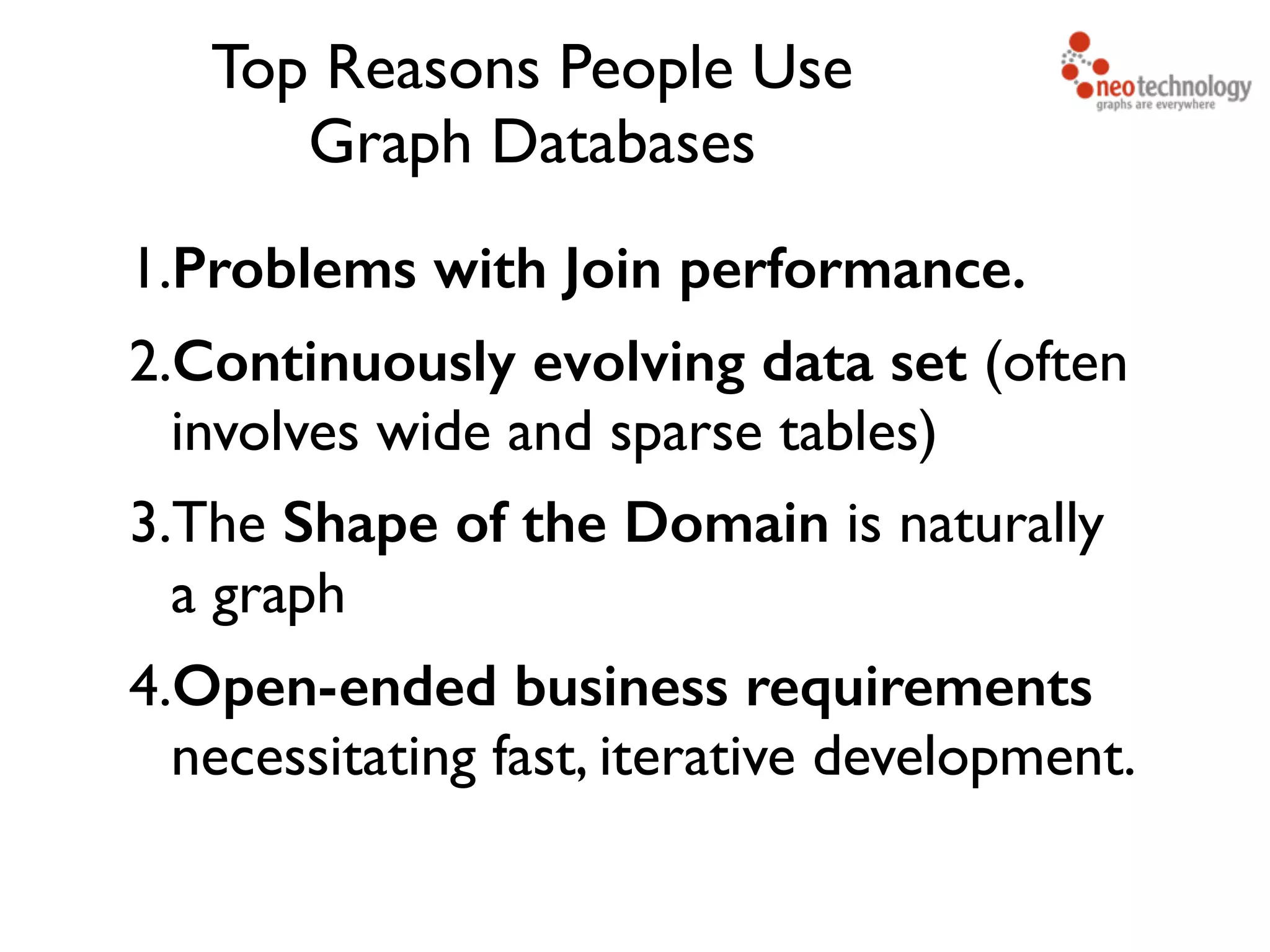

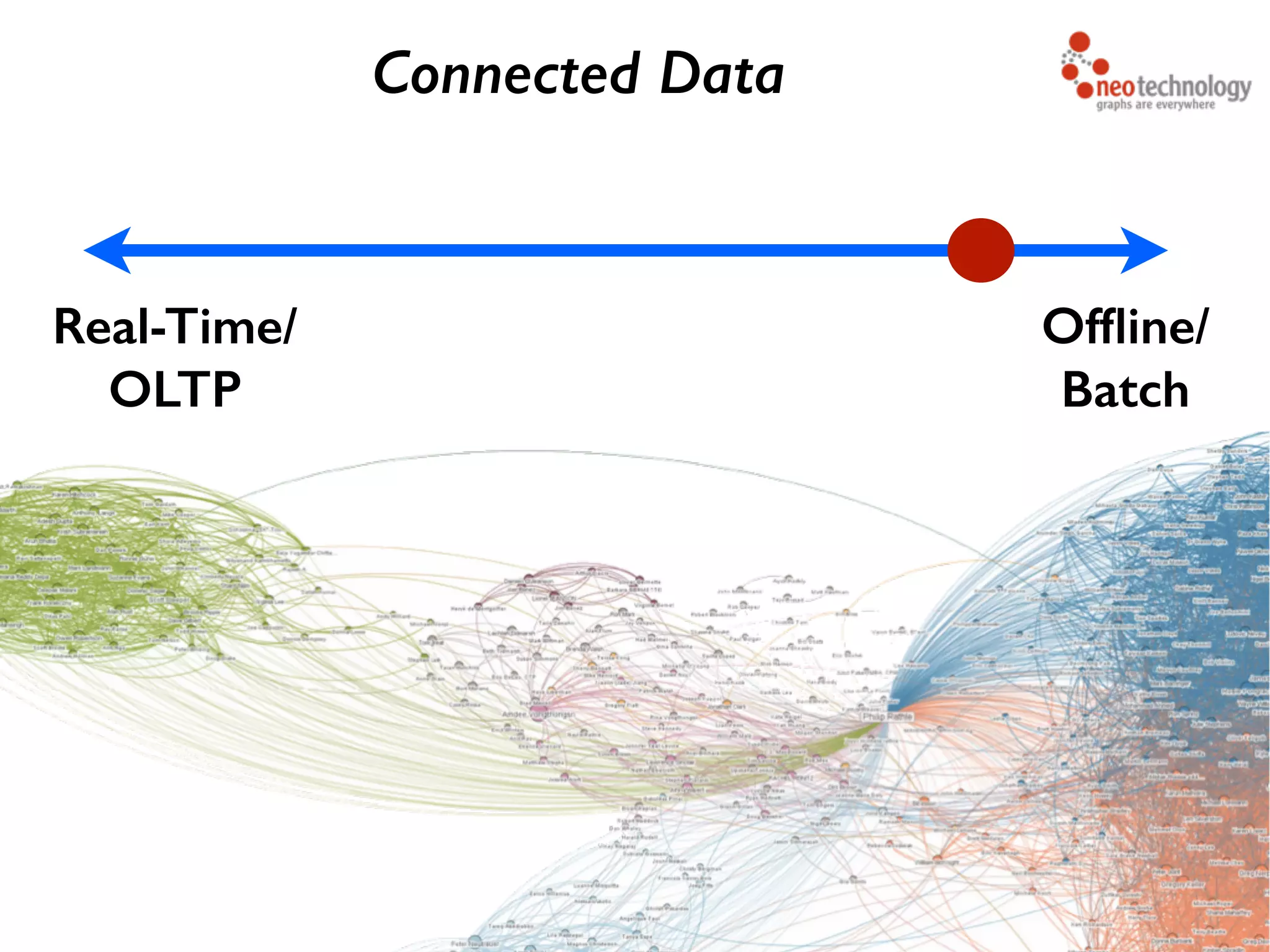
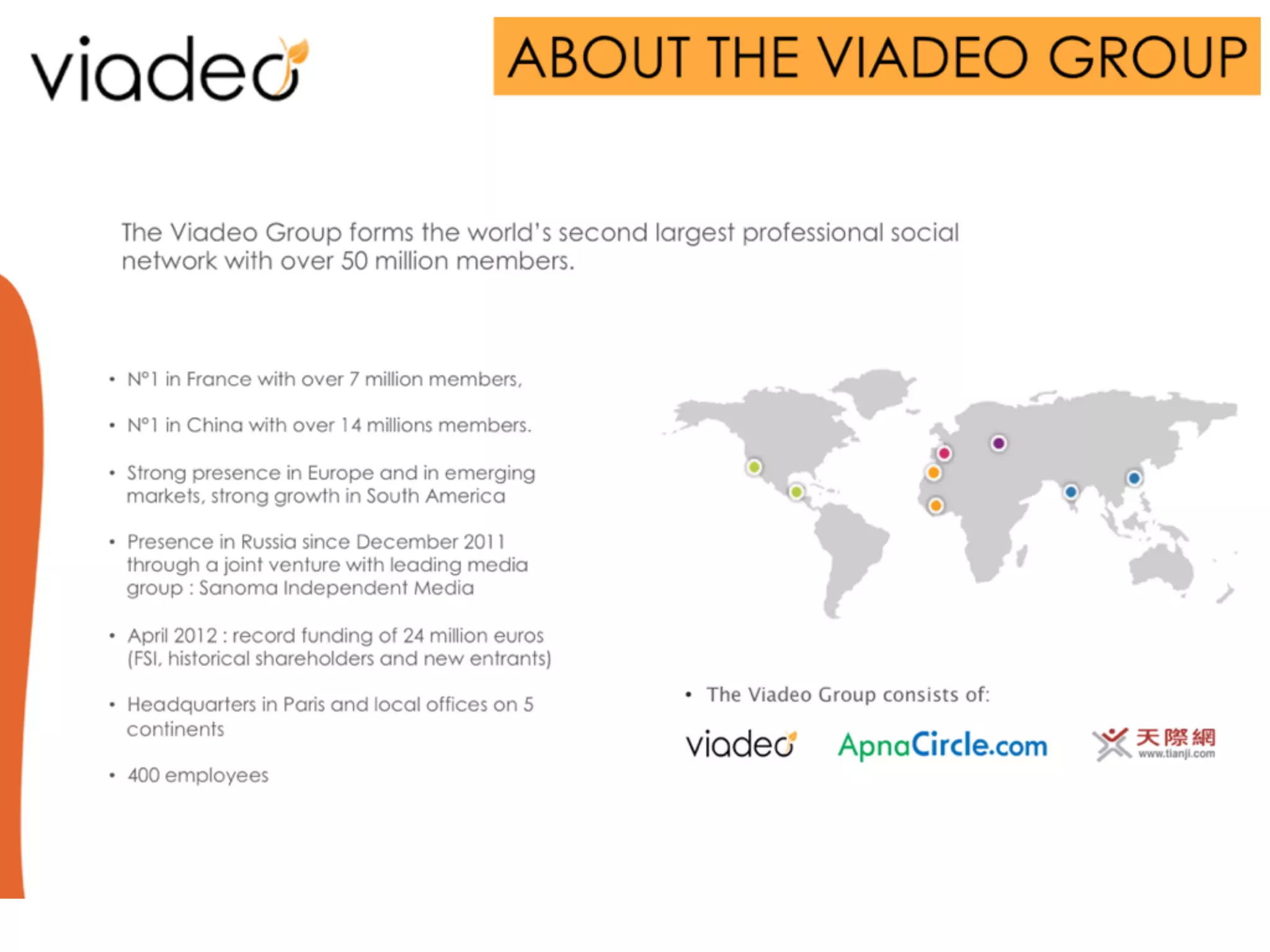
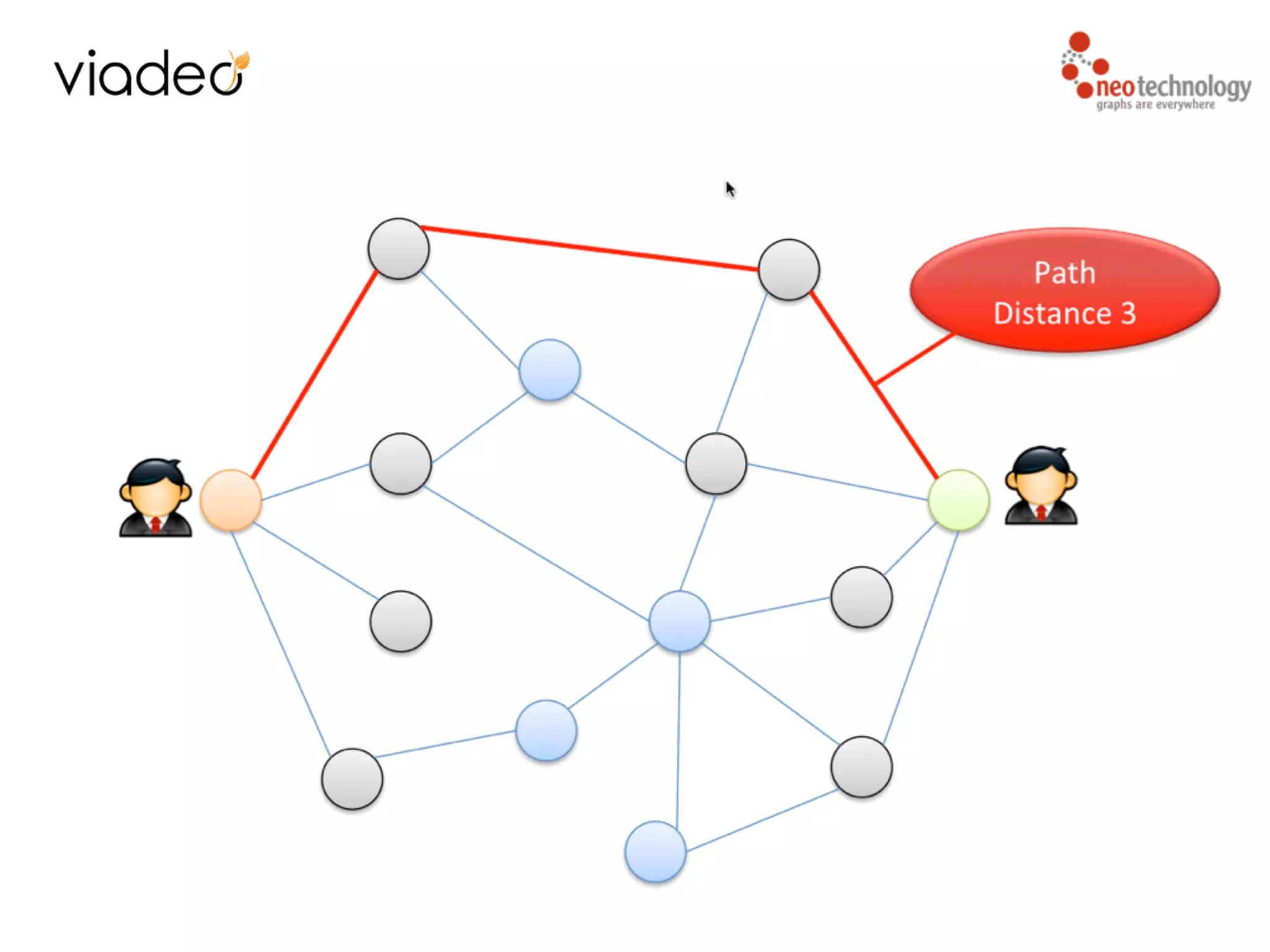

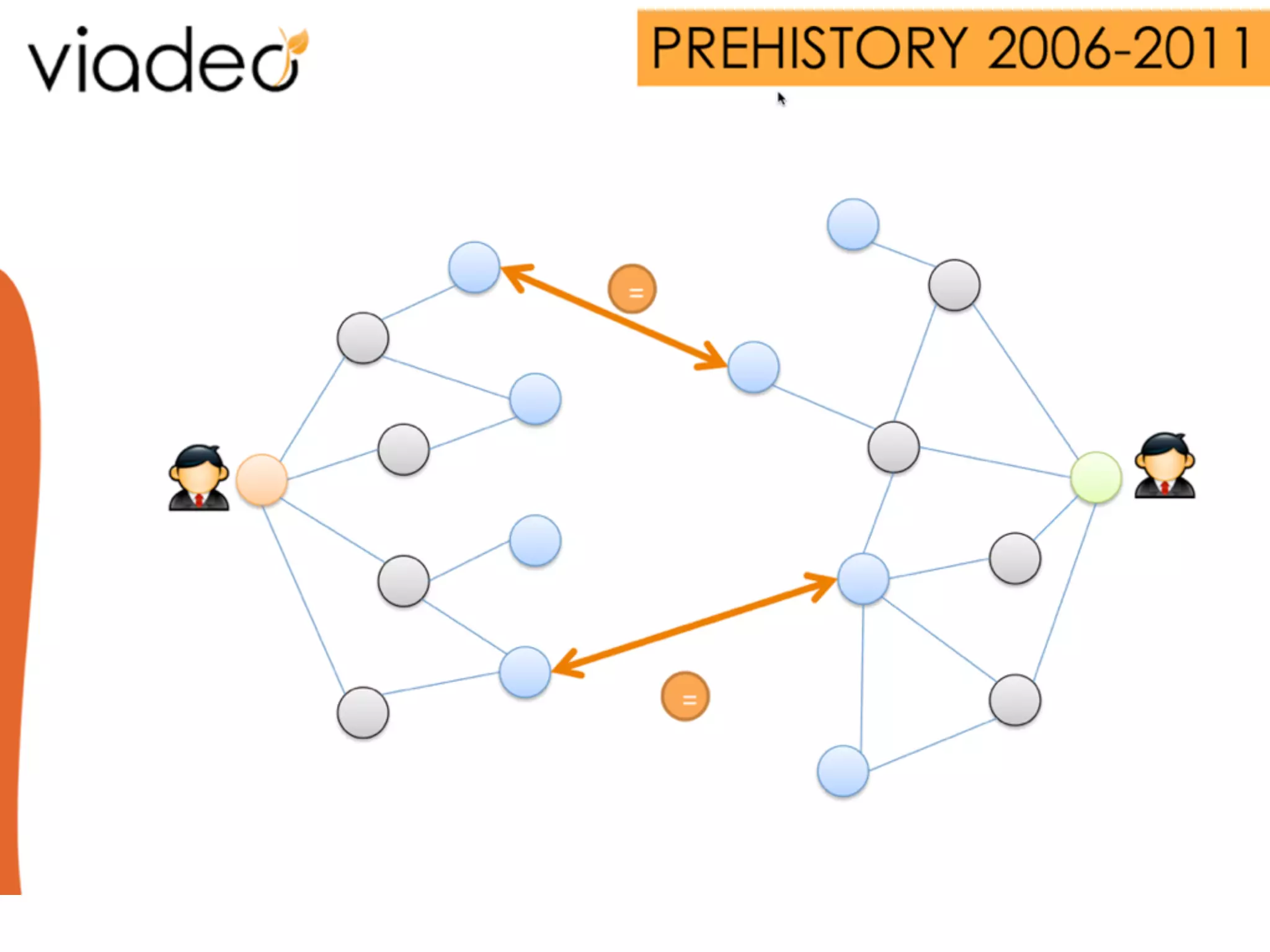
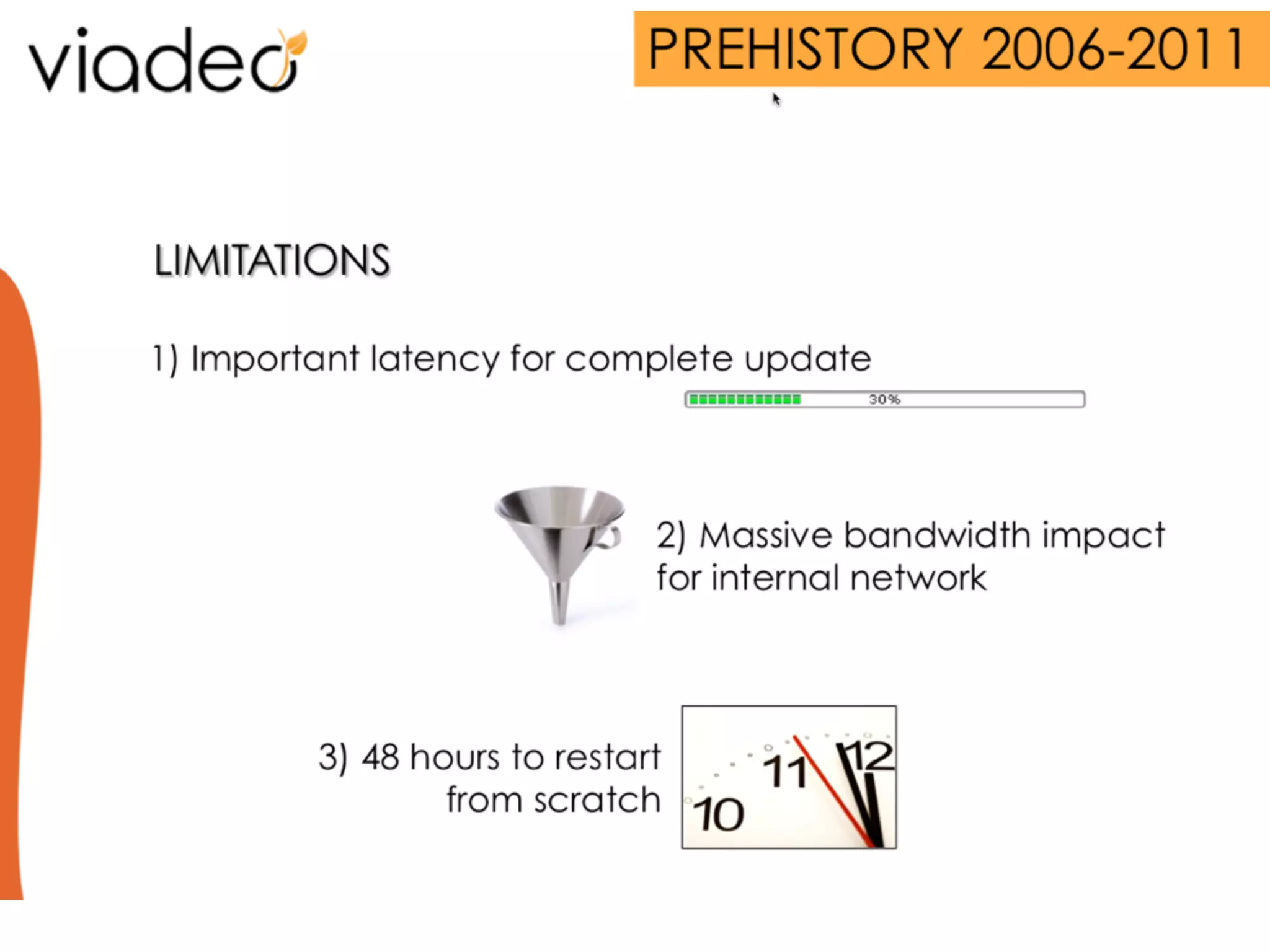
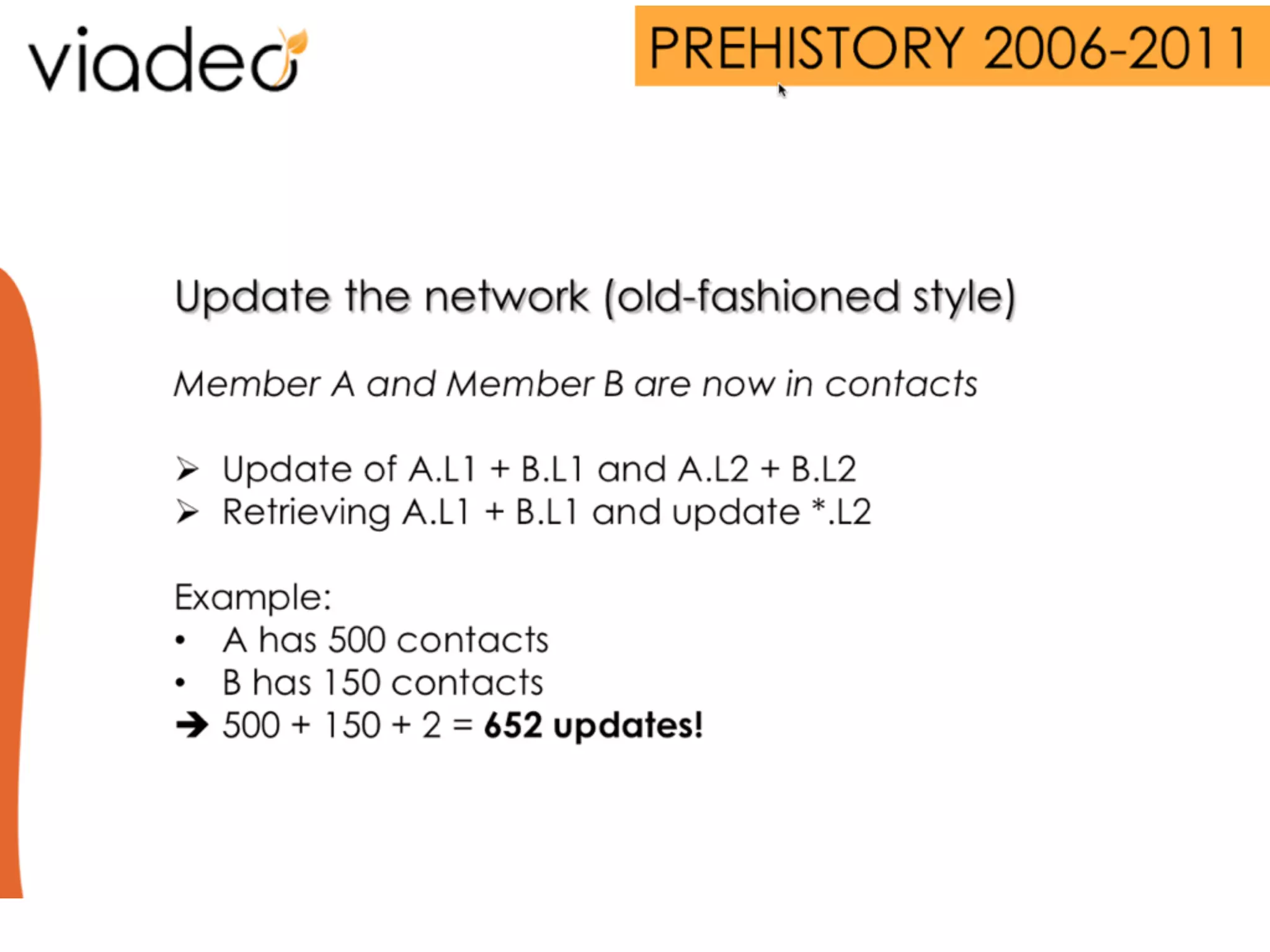

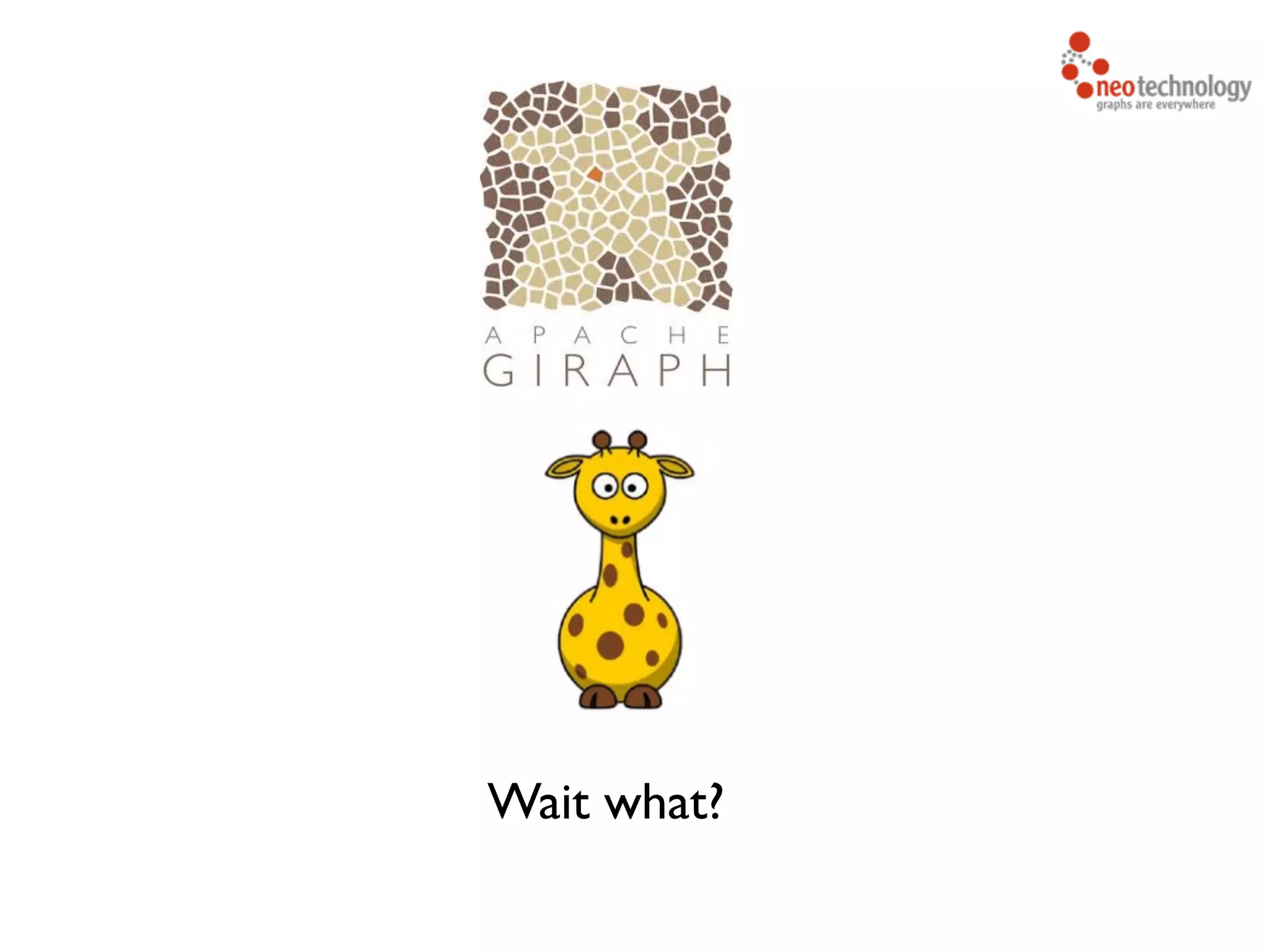
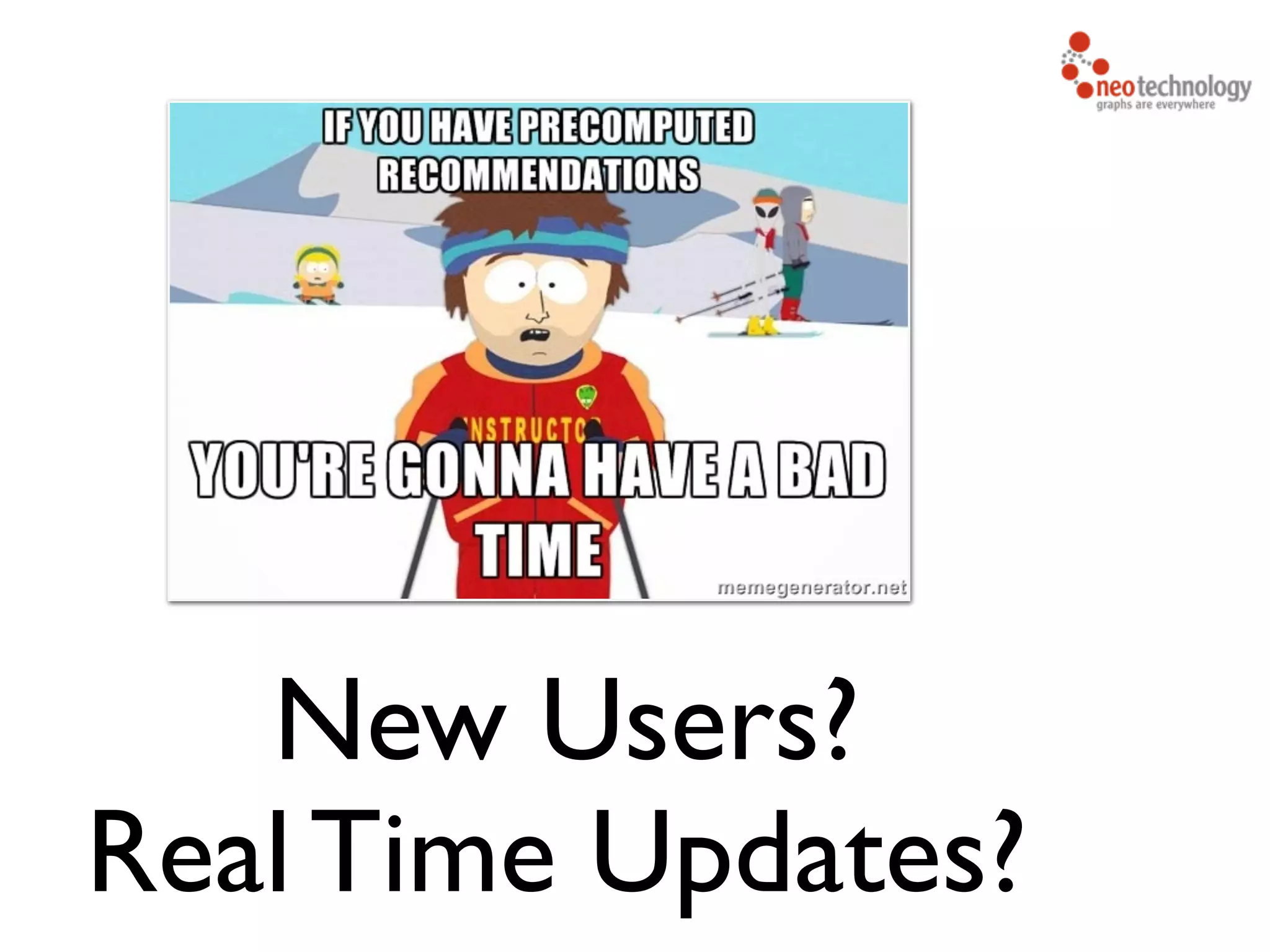
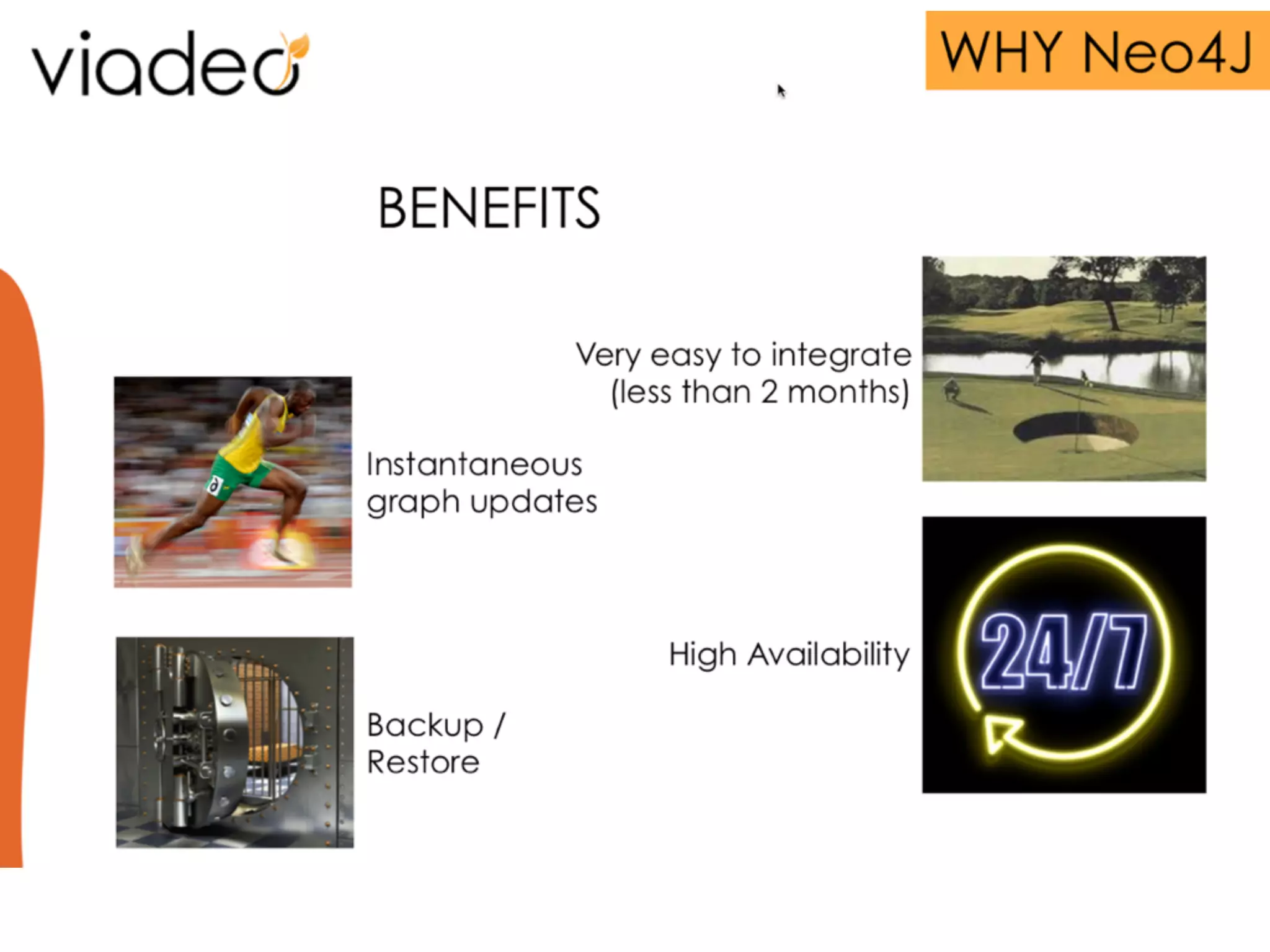




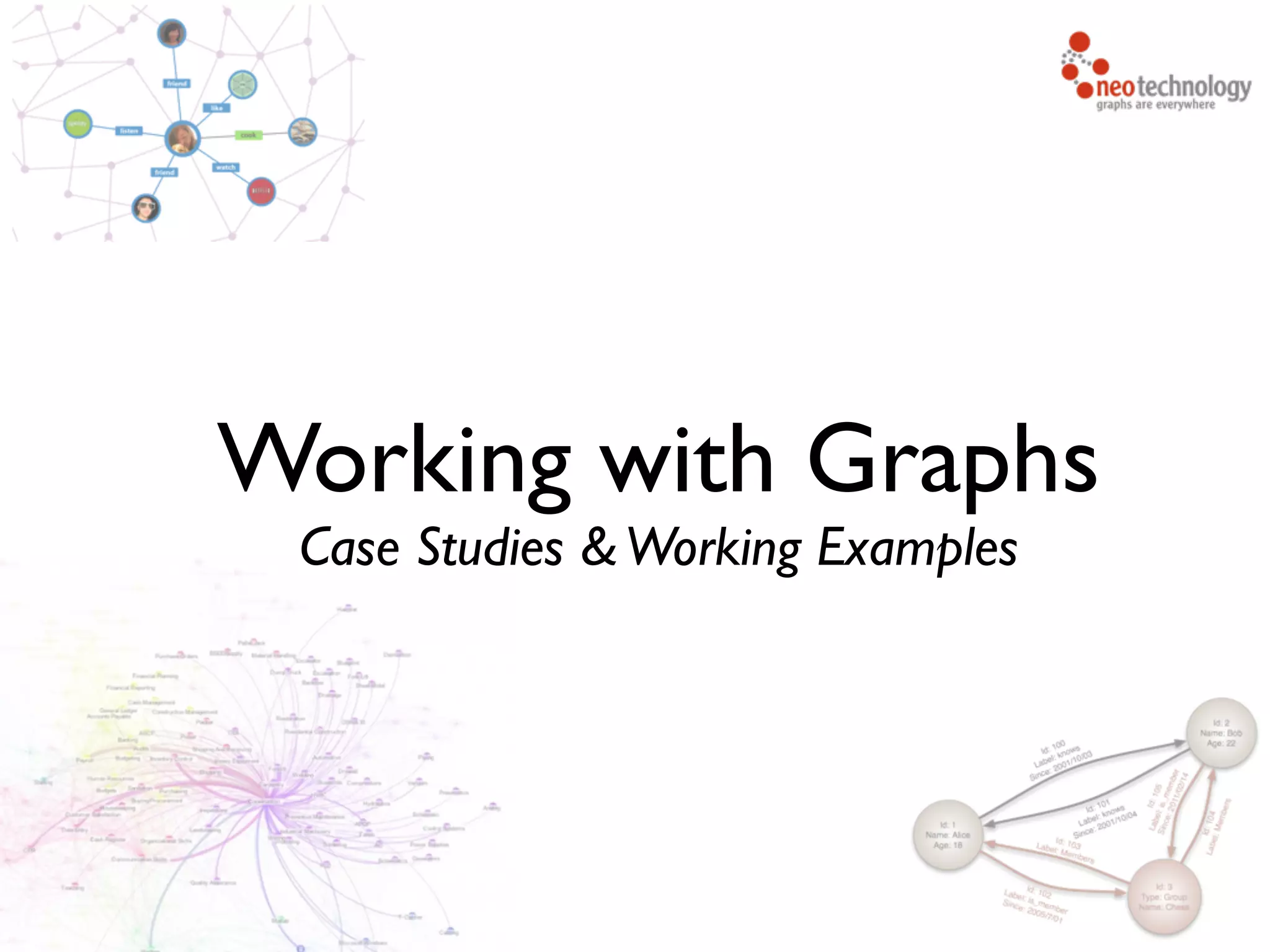
![Cypher LOVESA B Graph PatternsASCII art MATCH (A) -[:LOVES]-> (B) WHERE A.name = "A" RETURN B as lover](https://image.slidesharecdn.com/graphdatabaseusecases-stampedecon2015-150903113225-lva1-app6892/75/Graph-Database-Use-Cases-StampedeCon-2015-63-2048.jpg)

![Social Graph - Create Practical Cypher CREATE ! ! (joe:Person {name:"Joe"}),! ! (bob:Person {name:"Bob"}),! ! (sally:Person {name:"Sally"}),! ! (anna:Person {name:"Anna"}),! ! (jim:Person {name:"Jim"}),! ! (mike:Person {name:"Mike"}),! ! (billy:Person {name:"Billy"}),! ! ! ! (joe)-[:KNOWS]->(bob),! ! (joe)-[:KNOWS]->(sally),! ! (bob)-[:KNOWS]->(sally),! ! (sally)-[:KNOWS]->(anna),! ! (anna)-[:KNOWS]->(jim),! ! (anna)-[:KNOWS]->(mike),! ! (jim)-[:KNOWS]->(mike),! ! (jim)-[:KNOWS]->(billy)](https://image.slidesharecdn.com/graphdatabaseusecases-stampedecon2015-150903113225-lva1-app6892/75/Graph-Database-Use-Cases-StampedeCon-2015-65-2048.jpg)
![Social Graph - Friends of Joe's Friends MATCH (person)-[:KNOWS]-(friend),! (friend)-[:KNOWS]-(foaf) ! WHERE person.name = "Joe"! AND NOT(person-[:KNOWS]-foaf)! RETURN foaf ! Practical Cypher foaf {name:"Anna"}](https://image.slidesharecdn.com/graphdatabaseusecases-stampedecon2015-150903113225-lva1-app6892/75/Graph-Database-Use-Cases-StampedeCon-2015-66-2048.jpg)
![Social Graph - Common Friends MATCH (person1)-[:KNOWS]-(friend),! (person2)-[:KNOWS]-(friend)! WHERE person1.name = "Joe" ! AND person2.name = "Sally"! RETURN friend! ! ! Practical Cypher friend {name:"Bob"}](https://image.slidesharecdn.com/graphdatabaseusecases-stampedecon2015-150903113225-lva1-app6892/75/Graph-Database-Use-Cases-StampedeCon-2015-67-2048.jpg)
![Social Graph - Shortest Path MATCH path = shortestPath(! (person1)-[:KNOWS*..6]-(person2)! )! WHERE person1.name = "Joe" ! ! AND person2.name = "Billy"! RETURN path! ! Practical Cypher path {start:"13759", ! nodes:["13759","13757","13756","13755","13753"],! length:4,! relationships:["101407","101409","101410","101413"],! end:"13753"}](https://image.slidesharecdn.com/graphdatabaseusecases-stampedecon2015-150903113225-lva1-app6892/75/Graph-Database-Use-Cases-StampedeCon-2015-68-2048.jpg)
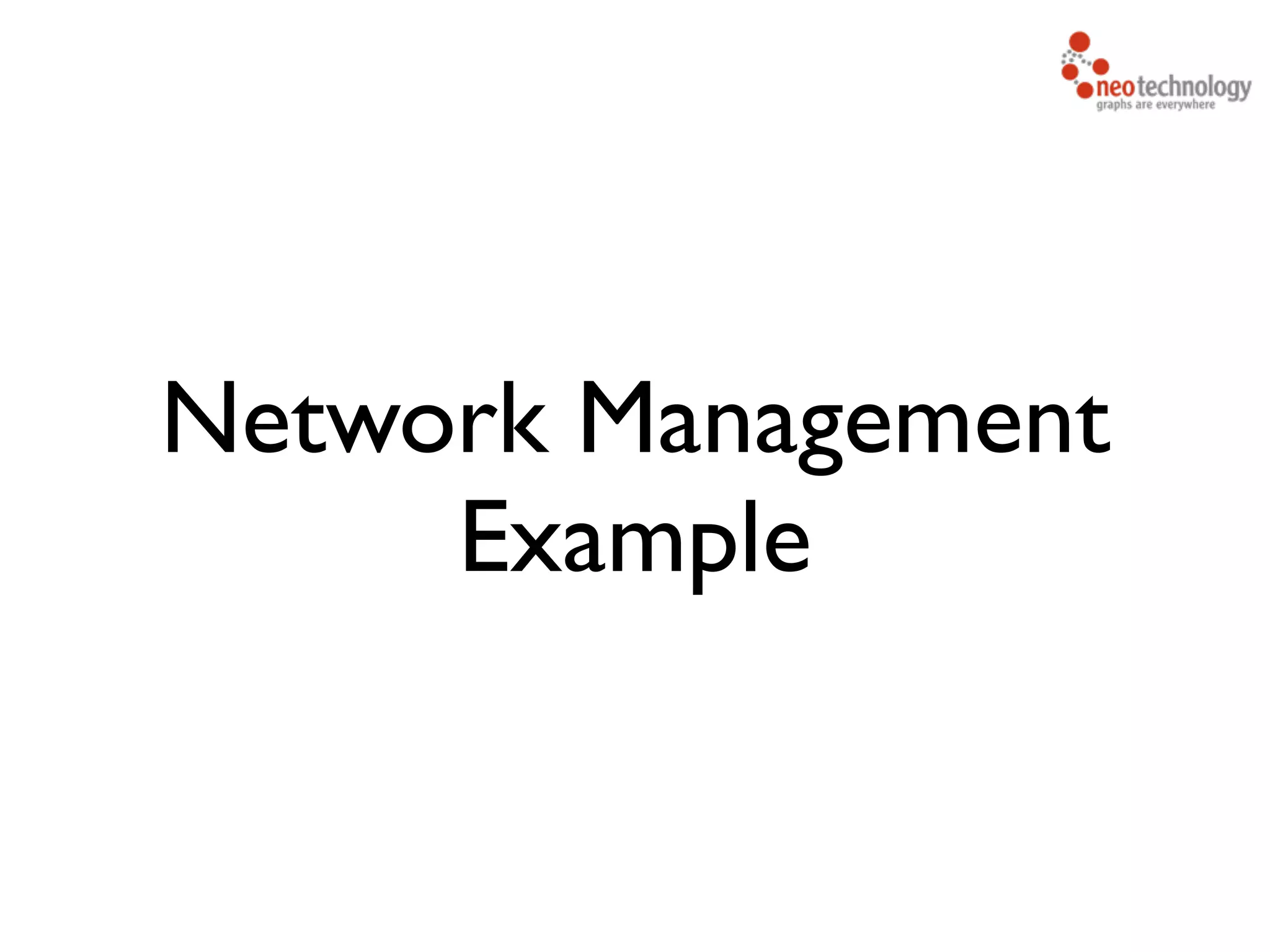
![Network Management - Create CREATE ! ! (crm {name:"CRM"}),! ! (dbvm {name:"Database VM"}),! ! (www {name:"Public Website"}),! ! (wwwvm {name:"Webserver VM"}),! ! (srv1 {name:"Server 1"}),! ! (san {name:"SAN"}),! ! (srv2 {name:"Server 2"}),! ! ! (crm)-[:DEPENDS_ON]->(dbvm),! ! (dbvm)-[:DEPENDS_ON]->(srv2),! ! (srv2)-[:DEPENDS_ON]->(san),! ! (www)-[:DEPENDS_ON]->(dbvm),! ! (www)-[:DEPENDS_ON]->(wwwvm),! ! (wwwvm)-[:DEPENDS_ON]->(srv1),! ! (srv1)-[:DEPENDS_ON]->(san)! Practical Cypher](https://image.slidesharecdn.com/graphdatabaseusecases-stampedecon2015-150903113225-lva1-app6892/75/Graph-Database-Use-Cases-StampedeCon-2015-70-2048.jpg)
![Network Management - Impact Analysis // Server 1 Outage! MATCH (n)<-[:DEPENDS_ON*]-(upstream)! WHERE n.name = "Server 1"! RETURN upstream! Practical Cypher upstream {name:"Webserver VM"} {name:"Public Website"}](https://image.slidesharecdn.com/graphdatabaseusecases-stampedecon2015-150903113225-lva1-app6892/75/Graph-Database-Use-Cases-StampedeCon-2015-71-2048.jpg)
![Network Management - Dependency Analysis // Public website dependencies! MATCH (n)-[:DEPENDS_ON*]->(downstream)! WHERE n.name = "Public Website"! RETURN downstream! ! Practical Cypher downstream {name:"Database VM"} {name:"Server 2"} {name:"SAN"} {name:"Webserver VM"} {name:"Server 1"}](https://image.slidesharecdn.com/graphdatabaseusecases-stampedecon2015-150903113225-lva1-app6892/75/Graph-Database-Use-Cases-StampedeCon-2015-72-2048.jpg)
![Network Management - Statistics // Most depended on component! MATCH (n)<-[:DEPENDS_ON*]-(dependent)! RETURN n, ! count(DISTINCT dependent) ! AS dependents! ORDER BY dependents DESC! LIMIT 1 Practical Cypher n dependents {name:"SAN"} 6](https://image.slidesharecdn.com/graphdatabaseusecases-stampedecon2015-150903113225-lva1-app6892/75/Graph-Database-Use-Cases-StampedeCon-2015-73-2048.jpg)
